What Do The Star Trek Uniform Colors Mean & Why Are They So Important?
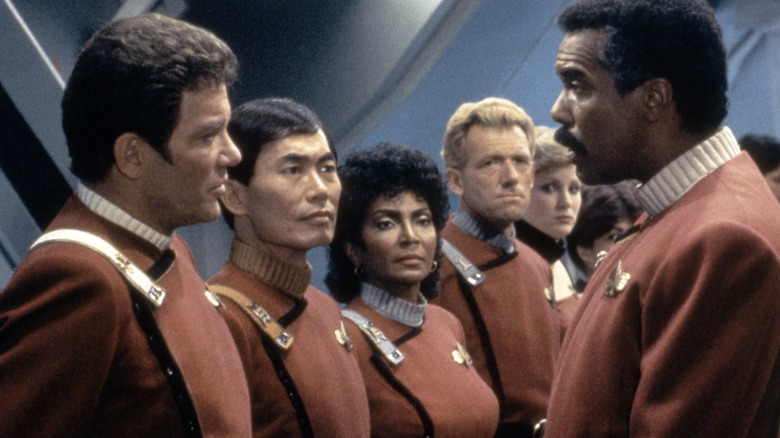
"Star Trek" is definitely a technicolor wonderland of a show. That sense of eye-catching brilliance trickles down from the background scenery to the props used by each cast member, all the way to the uniforms the show's central crew wears as a part of their duties.
It's easy to notice that the crew of the Starship Enterprise wear tunics in varying shades. Those colors are quite important — they denote which job class each crew member belongs to. Those classes were devised by series creator Gene Roddenberry and costume designer William Ware Theiss, and are intended to resemble the classifications used by the United States Military on noise-heavy aircraft carriers.
Sometimes there are differences allowed for dress uniforms; the command staff, for instance, will wear green uniforms during formal occasions. And these rules aren't hard and fast ones; across the whole universe of "Star Trek" series, films, and other ephemera, the colors various officers wear on the show and the meanings behind them change depending on when the scene takes place in the show's general timeline. But these are the color codes that most often denote each character's job on the ship, and the ones used during the original "Star Trek" series to explain who is who and what they do.

The term 'red shirt' gained a negative connotation
Even if you're not a "Star Trek" fan, you've probably heard jokes about how often red-shirted officers are introduced to the show, only for them to quickly die during away missions. For a period of time, the term "red shirt" became a dirty word in the "Star Trek" world; it's gone on to take on a larger cultural significance, indicating that a person is a disposable background element easy to get rid of. And yet many of the show's red-toting characters are the franchise's longest-lasting individuals. The class encompasses the engineering, security, and communication staff positions on the Enterprise. Lt. Nyota Uhura (Nichelle Nichols) and Montgomery "Scotty" Scott (James Doohan) are among the most prominent crew members who wear scarlet hues. To wear red on the bridge is definitely a high honor.
Are 'red shirts' more doomed than their counterparts? Mathematician James Grime weighed in on the subject during a talk at New York's Museum of Mathematics in 2017. A simple statistical calculation revealed that 10% of the show's red-shirted denizens die during the original show's run — compared to 18 percent of golden-shirted characters. "There is some truth in the old 'Star Trek' myth if you look at security officers ... 20 percent of security officers died. So I think the moral of the story is, if you're on the starship Enterprise and you want to survive, be a scientist," he said.
Ironically, crimson red was eventually used to denote a position of authority on the ship; the uniforms that debuted in "Star Trek II: The Wrath of Khan" place the crew in scarlet togs, with no color divisions to mark them.
Blue denotes a scientific mind
If you're feeling blue during your time on the Enterprise, then you're probably logically-minded. Throughout much of the original "Star Trek" series, blue uniforms were given to the show's science and medical officers. That's why Spock (Leonard Nimoy), Nurse Christine Chapel (Majel Barrett), and Dr. Leonard "Bones" McCoy (DeForest Kelley) can be seen sporting blue tunics throughout the series' run. The designation of blue uniforms hasn't changed much during the course of various "Star Trek" series; blue and purple shades are used to indicate ship medics in such continuations of the universe as "Star Trek: The Next Generation."
Blue was also the chosen shade for the crew uniforms in "Star Trek: The Motion Picture," with splashes of brown, oatmeal and white. This change didn't go over well with the cast. Their rebellion against the baggy uniforms went beyond their alleged unsightliness; costume designer Robert Fletcher sewed shoes into the bottom of each uniform, forcing the actors to ask their assistants for help in completing simple tasks such as going to the bathroom. A change was promptly made for the next film, and the red Navy-style uniforms stuck with the whole movie franchise until "Star Trek: The Next Generation" was launched.
Golden shirts denote power
Captain James T. Kirk (William Shatner), meanwhile, sports a gold-colored shirt. These are the outfits worn by those in command: largely, captains and other figures of authority. In other iterations of the show, gold tunics are worn by members of the ship's security staff. In any event, it's a uniform that denotes power.
But those shirts weren't actually intended to be golden at all; in reality, they were pale green tunics that were filmed as golden or orange-looking thanks to the sort of film the show used. According to an interview conducted with Bill Thiess in 1988 for Star Trek Prop Authority , it wasn't the show's intent to present Kirk and other captains as wearing gold at all. "It was one of those film stock things; it photographed one way – burnt orange or a gold. But in reality was another; the command shirts were definitely green." Unfortunately, thanks to that mistake the look has stuck, and Kirk's uniform is more often remembered as golden instead of green.
Whether they're sporting green or dodging danger in red, there's one thing officers on the Enterprise definitely know how to do – look stylish in a timelessly classical way.
What Do the Different Uniform Colors Mean on ‘Star Trek’?
By jason serafino | mar 30, 2023, 3:23 pm edt.
Gene Roddenberry may have dreamed of a perfect future when he created Star Trek , but parts of his vision were firmly rooted in the real world, specifically in the physical makeup of the crew of the Enterprise itself.
Roddenberry, along with the show’s producers, decided to take numerous cues from the United States Navy when creating the official ranks on the show, including a captain overseeing a crew made up of a commander, a handful of lieutenant commanders, lieutenants, and several subordinate roles. But it’s the different colors of the Starfleet uniforms that really tell the story of how the Enterprise operates.
Fans know the basics: an array of blue, red, and gold shirts line the bridge of the ship every episode. Those colors weren’t just randomly picked for the sake of diversity, though. They actually correspond to the ship’s various service roles . The gold shirts are worn by the command division, which includes Captain Kirk, Lieutenant Sulu, and Pavel Chekov. Red uniforms belong to the engineering/communications division, including chief engineer Scotty and communications officer Uhura. The blue shirts are worn by the science/medical staff, including McCoy and Spock .
As with everything in Star Trek , though, it’s a lot more complicated than all of that. In addition to the red shirts belonging to engineers and communications personnel, they are also assigned to the security division. What’s the purpose of the security division on the Enterprise ? Well, they’re usually the supporting characters who are immediately killed whenever the crew is confronted by a new enemy. This is something of a running gag for fans of the franchise, as whenever one of the “Red Shirts” is seen on screen, you know they’re not long for this world .
Also, those gold shirts worn by Kirk and crew might not have been so gold after all. According to an interview with Star Trek ’s costume designer, William Theiss, the idea was for the show’s uniforms to be red, blue, and green. In fact, on the set, Kirk’s outfit certainly looked to be an avocado (or lime) green, but the end result was a little different when the studio lights finally hit the uniform.
“It was one of those film stock things,” Theiss said, “it photographed one way—burnt orange or a gold. But in reality was another; the command shirts were definitely green.”
This might come as a surprise to Trek fans until you remember that Kirk actually did wear green on a few occasions, including the times he was in formal dress and his seldom-seen alternate green get-up, seen in the clip below.
These alternate uniforms were all the exact shade of green Theiss describes, but they were made from a different material than the standard Enterprise shirts and apparently had no issue retaining their natural color scheme when lit on set. The gold shade may have been a production mishap, but the color has since entered the Trek canon as the official hue of Kirk and his command staff. So, in the Star Trek universe, Kirk wears gold; in the real world, though, the bridge of the Enterprise was designed with a completely different color palette in mind.
It gets more confusing when you look at the later Trek series, like The Next Generation , which had the command staff in red and operations in yellow—basically the reverse of the original series. Then, of course, the movies switched costumes and colors with nearly every entry, including the powder blue monstrosities worn in Star Trek: The Motion Picture .
Roddenberry’s eye for detail was unique for sci-fi TV at the time, and everything on the Enterprise had a specific purpose. Despite some production fumbles, ill-fated redesigns, and inconsistencies later on, the colors that make up Starfleet’s uniforms tell a story that many viewers probably never even noticed.
A version of this story originally ran in 2016; it has been updated for 2023.

- Entertainment
- PlayStation
- Elden Ring Guides
- Roblox Codes
- Pokemon Legends Arceus
- Privacy Policy
- Terms of Service
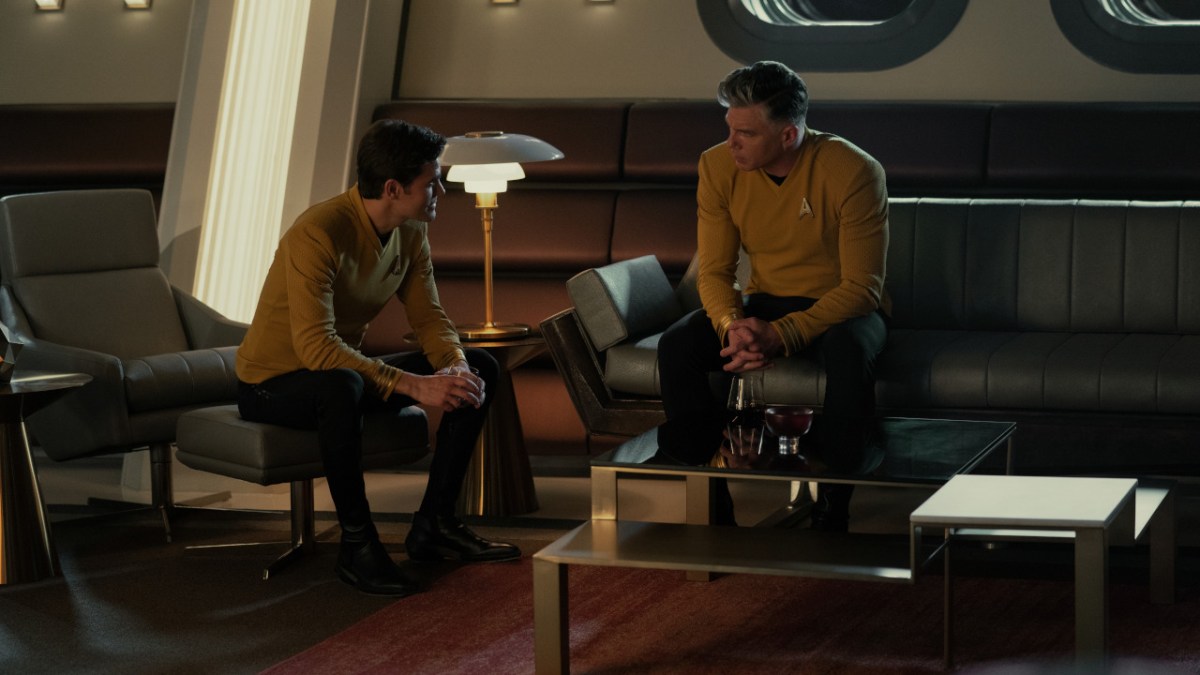
Every Shirt Color in Star Trek, Explained
Every shirt color in Star Trek has meaning and I’ll try my best to explain to Trekkies and non-Trekkies alike what that is. You know how some schools and most jobs require students and employees to wear uniforms? Well, Starfleet basically does the same with its officers. In The Original Series , Commanding officers wear gold, science officers wear blue, and engineering officers wear red. But what does that mean for all the different iterations of Star Trek ?
Commanding Officers of Star Trek
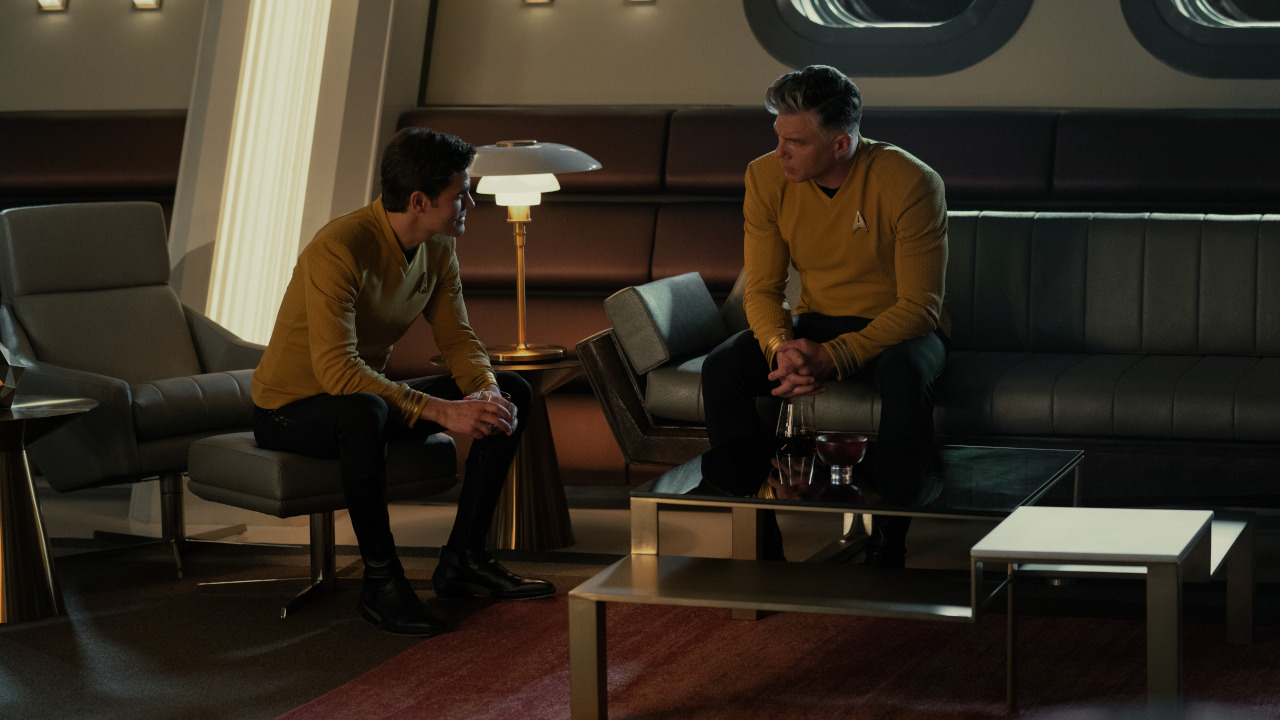
The classic shirt color of those in command positions is gold. Unless we’re talking about Captain Kirk’s green formal top in the “Journey to Babel” episode of The Original Series . (Captains Pike and Kirk revive these prime colors in Strange New Worlds .) Then Captain Picard came along in The Next Generation and the colors shifted to red and black.
Enterprise was later content to put Captain Archer in something that looked more appropriate for a car shop than an important space mission. But who are we to judge?
Discovery has since returned to red with gray sometimes peppered in for more official occasions. Luckily, however, it’s not the color of shirts that make the leader. It’s the person within them and how willing they are to make morally dubious decisions.
Related : 10 Best Star Trek Battles, Ranked According to IMDB
Science Officers of Star Trek
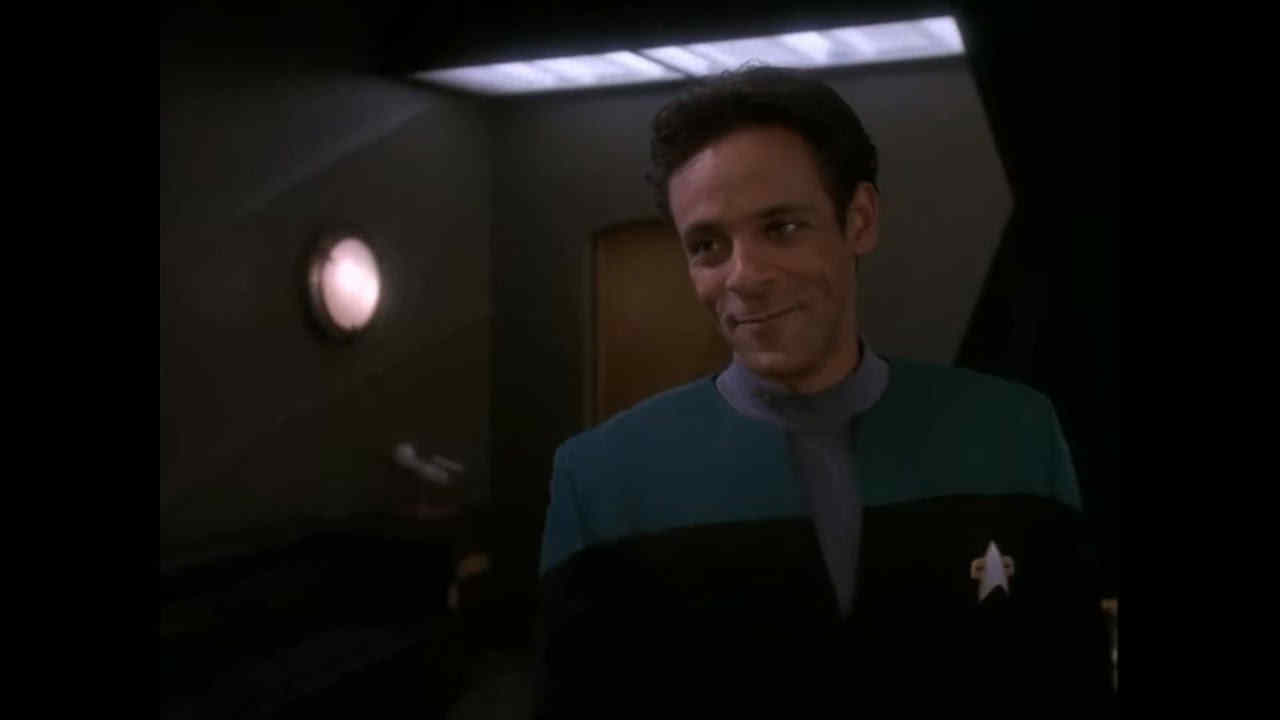
The shirt color of science officers has consistently been blue throughout Star Trek . The types of blue may change depending on what series you’re watching. Nevertheless, though, blue seems to be the staple of officers overwhelmed with trying to keep their officers alive from planet to planet.
Dr. Julian Bashir showed up in Deep Space Nine with a brash, overly confident can-do attitude. He was the first doctor in Star Trek to be yelled at rather than doing the yelling. He was also the first one to grow before our very eyes into a competent and dependable professional. But the blue in the collar of his shirt spoke to the tradition of those who came before him. For that, Dr. McCoy would be most proud.
Engineering Officers of Star Trek
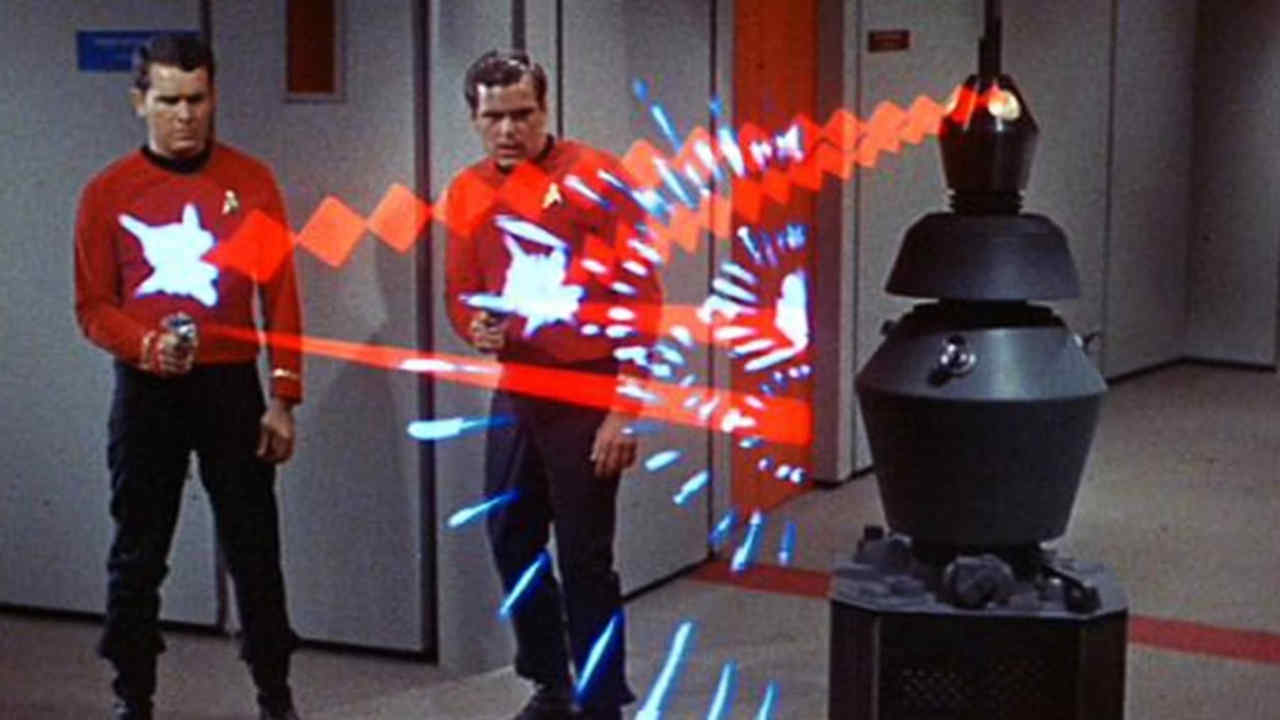
Speaking of tradition, the Red Shirts have continued to be synonymous with bad luck no matter what Star Trek TV series or movie they’re in. Everyone else is in a sci-fi story with hints of comedy and drama. Meanwhile, the Red Shirts are in a horror movie where they go off to investigate strange happenings and then just never come back.
Lt. Uhura is perhaps one of the only Red Shirts to make it out of a Star Trek series alive. Chief Engineers always do well because they’re part of the main cast and really likable (for the most part, at least). Taking Odo out of a Red Shirt probably saved his life. Then again, the chances of anything taking out Odo were slim anyway.
Hopefully, I’ve successfully explained the meaning of every shirt color in Star Trek . There are a lot of variations that have appeared through the years. All of the Enterprise crew, for example, just looked like mechanics. Even Discovery doesn’t have much variation in how the officers dress. Will that change with future Star Trek projects ? Only time – and Paramount Plus budget – will tell.

Star Trek Uniforms Fully Explained
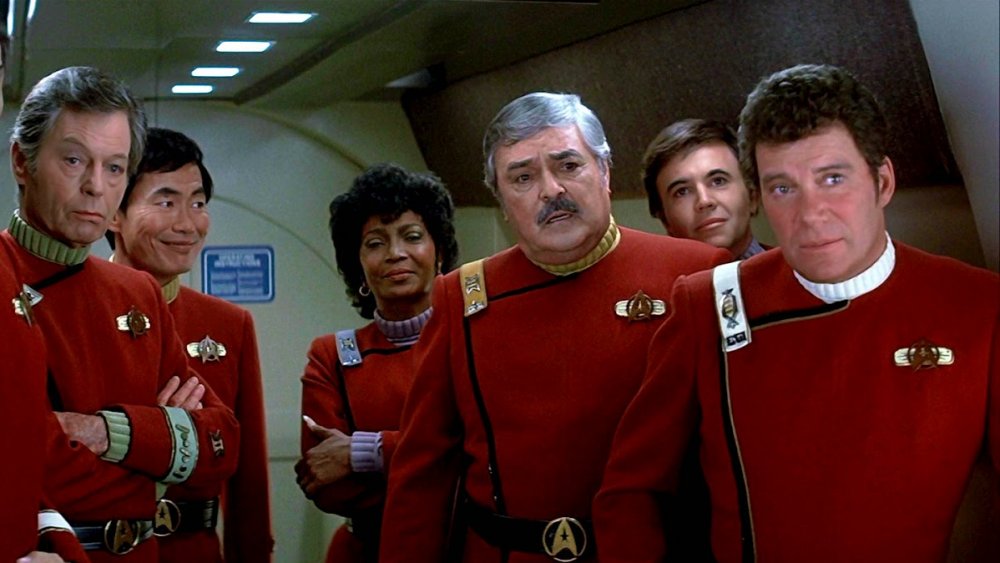
Since its premiere more than 50 years ago, Star Trek has been at the center of a growing web of culture, television, film, and fandom. With nine television series and 13 films, with undoubtedly more to come, there is a wealth of material to analyze and enjoy. Today, an enthusiastic fan can take just a single aspect of the Star Trek universe and dive into it for weeks.
Take uniforms. A seemingly simple concept, right? Star Trek generally focuses on the experiences of people serving in Starfleet, essentially a futuristic version of the Navy in space. So, Starfleet uniforms should be fairly consistent, even boring. Everyone's supposed to look like a cohesive group, so there should be little variation.
However, the uniforms of Star Trek are so varied and connected to the intricate fictional world of the franchise that it's pretty fascinating. Someone appearing on Star Trek: The Next Generation and then showing up again in a film like Star Trek: First Contact will probably have to fit themselves into two very distinct outfits. With more than five decades of stuff to go through, says CNET , there's a dizzying variety of looks for what's supposed to be a pretty staid quasi-military organization.
Practically everything about the history of Star Trek uniforms is linked to behind-the-scenes stories, real-world creativity, in-universe drama, and even a touch of fashion history here and there. From color, to cut, to material, there's a lot to learn.
Color is key to Star Trek uniforms
In Star Trek: The Original Series , which ran from 1966 to 1969, you can't miss the brightly hued uniform shirts sported by the crew of the starship Enterprise . Captain James T. Kirk and other members of the command staff sport golden yellow tops, says Mental Floss . Blue is reserved for the science department and medical personnel, so you'll see it on Mr. Spock, the second-in-command, and the ship's physician, Doctor McCoy.
And what of the folk in red uniforms? According to Star Trek lore, these poor "redshirts" are little more than cannon fodder, though, officially, red is for communications, admin, and security. If you're watching an episode where a random, red-clad crewmember is asked to beam down to the planet with the main cast, don't get too attached. They're probably going to get zapped, eaten, or otherwise annihilated to further the episode's plot.
Of course, there are some exceptions. Statistically speaking, says Nerdist , redshirts are not that bad off. Consider also that red shirts adorn major characters like Scotty, the ship's chief engineer, who made it through the entire series.
Now that you've got that settled, remember that it's only good for one series. In later Star Trek shows, red and gold switched places. Captains like The Next Generation 's Jean-Luc Picard wore a dark red, while his security chief, Worf, wore gold.
Starfleet rank is shown by pips and stripes
Like so many real-world military organizations, Starfleet hinges on rank. Crewmembers are expected to follow orders, but on starships that can carry thousands of people, who are they supposed to take seriously? That's where the rickrack comes in.
In Star Trek: The Original Series , rank was denoted by stripes of gold ribbon on someone's sleeves. The more stripes, the higher the rank. Generally speaking, says Atlas Obscura , two or three stripes means a captain. Commissioned officers are a safe bet for one stripe. Non-commissioned people get either a bit of braid or nothing at all. The stripes were brought back for the reboot films beginning in 2009.
The follow up series, Star Trek: The Next Generation went for something different during its 1987 – 1994 run. The colors became a more muted, and the old rank stripes, which, frankly, looked like something you might have picked up from your local craft store, were retired. In their place, officers wore "pips," subtle little pins, on their collars. The higher someone's rank, the more pips they sported.
Other films played around a bit with the rank symbols, like the different colors and badges shown in 1982's Star Trek II: The Wrath of Khan . Still, they weren't too off the original mark. Generally speaking, the more junk on someone's uniform, the more likely it is that you'll have to follow their orders.
The original series went for velour
Futurama 's Zapp Brannigan character, a send-up of Captain Kirk, is all about his velour uniform. The first Star Trek series really was into luxurious velour, too, but the fabric proved challenging to maintain. It's not as if the 1960s were known for comfortable natural materials, after all.
According to Esquire , the fabric initially used in Star Trek: The Original Series was a little flashy. Costume designers used a stretch cotton velour for the tops, with a black synthetic Dacron infused with sparkles for the pants. Both materials were meant to subtly glitter under studio lights, lending the uniforms a shimmery, 23rd-century, spacefaring feel.
Unfortunately, the velour was a flop. Many called it "that rotten velour," noting that the fabric tended to shrink in the wash and could tear easily. In the third and final season, designers substituted it for a double-knit nylon, says CNET , which proved to be a much hardier fabric, especially when it got thrown into the washing machine.
Captain Kirk's special green shirt was a little embarrassing
Originally, reports Atlas Obscura , the command staff of Star Trek: The Original Series was supposed to be sporting a muted green. Under the studio lights, though, the cameras read the green velour as a golden yellow. The production team simply went with it for the rest of the series.
Careful observers of the 1960s run will note that Captain Kirk is sometimes seen in a very green tunic-style shirt. According to an interview with series costume designer Bill Theiss , that's because it was made out of a different material. That particular shirt looked genuinely green. This is also why some of the colors in the original series seem to change, said Theiss. Even the miniature of the Enterprise could appear ever so slightly green under the right conditions.
William Shatner, the Canadian actor who played Kirk, wasn't necessarily fond of the tightly wrapped look, says Cinemablend . "It was a little embarrassing after lunch to have that tight green thing on you," he said.
Star Trek's women went from pants to miniskirts
The first pilot episode of Star Trek: The Original Series , " The Cage " is an odd duck. Though it was shot in 1964, it didn't make it to screens in its complete form until a Betamax release in 1989. Bits of the story were included in the season one two-parter "The Menagerie," but it contained only the briefest glimpses of what might have been.
These included things like a smiling Spock, different uniforms, and a woman in command wearing pants . Star Trek: The Original Series is notorious for its gendered uniforms. The men wore pants and long-sleeved shirts. Female crewmembers were confined to miniskirts so short that Lieutenant Uhura, the communications officer, always seemed on the verge of an embarrassing situation when she sat down.
That's partially why Number One, the second-in-command in "The Cage," stands out: She's wearing pants. Number One, played by Majel Barrett, is also a daring commander. But she wasn't considered right for the character. When Star Trek got its second pilot, none of the women were in command, and certainly none of them wore pants. Barrett returned, albeit as the emotional, mini-skirted Nurse Chapel.
Nichelle Nichols, who played Uhura, offers up a counterpoint. "I was wearing [miniskirts] on the street," she told the BBC . "What's wrong with wearing them on the air? [...] It was the era of the miniskirt. Everybody wore miniskirts."
The first Star Trek movie shook took uniforms in a weird direction
Star Trek: The Motion Picture looked like it was going to be a big deal. The 1979 film was the first time that fans would get to see their beloved crew on the big screen. Anticipation was high. Then, the movie debuted.
It landed with a dull thud. While die-hard fans still got enjoyment out of Star Trek 's film debut, most viewers couldn't get past the plodding story and dialogue-heavy scenes. It made just enough profit to justify a sequel, to be sure. SyFy contends that The Motion Picture did originate some interesting new trends for the franchise, like wearable communicators and redesigned Klingons . Still, few would point to this entry as their favorite Star Trek movie.
Some of the blame surely lies with the redesigned uniforms. Where The Original Series had colorful, if somewhat cartoonish togs for the crew, The Motion Picture made it look like everyone was going to the weirdest slumber party ever. According to Memory Alpha , the crew was now outfitted in two-piece tunics and one-piece jumpsuits in mind-numbing shades like pale blue and beige. At least the women on the crew were dressed in the same jumpsuits worn by the men. They might have looked oddly dull for space adventurers, but crewmembers like Lt. Uhura didn't look like they needed to worry about errant breezes. And, if nothing else, the space pajamas look pretty comfortable.
The Wrath of Khan redeemed Star Trek uniforms while cutting costs
Though Star Trek: The Motion Picture began the series tradition of changing Starfleet uniforms at every opportunity, rebooted uniforms didn't get very eye-catching until the second film. In Star Trek: The Wrath of Khan, both the plotting and the uniforms got a much-needed upgrade.
To be fair, the striking red jackets of The Wrath of Khan wouldn't have existed as we know them if it weren't for the beige jumpsuits of The Motion Picture . As revealed by Empire , costume designer Robert Fletcher, burned somewhat by his experiences on the first film, decided to stay on in an attempt to redeem his craft. Fletcher still had to work within budget, says Forgotten Trek . Indeed, the budget was smaller, since the studio had been spooked somewhat by the lackluster performance of the first motion picture. As a result, Fletcher rather cleverly utilized the old movie uniforms. His team dyed the tunics red because that was the shade that took best to the fabric.
Meanwhile, Fletcher added a few more militaristic details to the revamped uniforms, like boxy shoulders, stripes, and shiny rank insignia. Fletch referred to it as "Hornblower in outer space," referring to the popular Horatio Hornblower series, set in the era of the Napoleonic Wars. The maroon color proved so successful that it persisted far beyond the film and back onto television with the follow-up series, Star Trek: The Next Generation.
Star Trek: The Next Generation's uniform was all about spandex
While the uniforms debuted in Star Trek: The Wrath of Khan were structured, boxy outfits inspired by military getups, the theme wasn't going to last, for William Ware Theiss, who designed the costumes for Star Trek: The Original Series , was ready to completely revamp even his own designs. Theiss was called upon to design the costumes for the first year of Star Trek: The Next Generation , the follow-up series that premiered in 1987. According to Forgotten Trek , Theiss wanted to pull back from the structured look of Wrath of Khan and return to a softer appearance.
That meant spandex. Specifically, Theiss employed a heavyweight material, of the type often used for swimsuits. He also changed the color scheme, making red the color for command staff, while gold was switched to engineering and security. Blue remained the key shade for medical and science personnel.
While designers might have liked the spandex, it got poor reviews from the actors. The form-fitting material was unforgiving of a heavy lunch or brief dalliance with a slice of cake. Robert Blackman, who replaced Theiss in later seasons, came to the rescue with a different cut and wool fabric. Unfortunately, only the male actors got the best changes, like two-piece uniforms. Female actors like Marina Sirtis, who played Counselor Troi, were stuck in uncomfortable one-piece jumpsuits for a while longer.
Deanna Troi's exception confused Trek fans
In Star Trek: The Next Generation , ship's counselor Deanna Troi was actually a Starfleet officer, but you wouldn't know it from her clothes. While everyone else on staff was wearing the regulation Starfleet uniform, Troi was often stuck in revealing onesies that recalled the first film's unfortunate jumpsuits.
It may have something to do with Troi's gender. As quoted at Forgotten Trek , Marina Sirtis, who played Troi, took a dim view of how the show treated female characters. "The women on this show are very non-threatening," she said. "You don't see women in power positions." Troi was meant to be a soft, caring therapist. Perhaps her clothing was meant to reflect that gentleness, but with an admittedly sexist twist that lowered her necklines and kept Sirtis trapped in revealing spandex for much longer than her coworkers. Too often, her clothes reflected stories where Troi was made to be helpless or even outright dull for the sake of the plot.
Counselor Troi finally got to wear the real uniform in "Chain of Command, Part 1," a season six two-parter. In it, Captain Jellico, an uptight fill-in for Captain Picard, curtly tells Troi to just wear the uniform already. While the impetus for the wardrobe change might have been embarrassing for her character, Sirtis was delighted. As she told the BBC , "I was thrilled when I got my regulation Starfleet uniform [...] I got all my brains back."
The "skant" tried to reach gender equality but fell flat
We should give Gene Roddenberry some credit. While he was often of his time for things like scantily clad secondary characters on Star Trek: The Original Series , he genuinely tried to push back against cultural assumptions. Sometimes, it worked and became practically legendary, as when he helped to create a diverse bridge crew on the first television series. Other times, he pushed for costume parity that simply didn't land.
Roddenberry was involved with the production of Star Trek: The Next Generation from its 1987 premiere until shortly before his death in 1991. He was part of almost everything in the series, including the costume design. As reported by Star Trek.com , Roddenberry directed designer William Ware Theiss to design what became known as the "skant."
This take on the minidress was made out of the same spandex as the other uniforms. It was also meant to be unisex. Crewmembers of any gender would be able to wear the thigh-baring skant. Yet, it was a hard sell. The skant was ever-so-briefly seen on a male crewmember here and there in the first season, says SyFy, but never after that. Female crew like Counselor Troi wore it a bit longer, but actors and viewers alike thought it just made her look like a space cheerleader. Though you can understand what Roddenberry and company were going for, the skant just couldn't stay. It faded into fan lore and obscurity soon after the first season.
Star Trek: Deep Space Nine made the uniforms fit for actual work
Star Trek didn't stop with Star Trek: The Next Generation . The sequel series was followed up by a progression of films and further television series. These included Star Trek: Deep Space Nine , which premiered in 1993 and briefly ran concurrently with The Next Generation . Though both series are supposed to take place at roughly the same time, the uniforms seen on Deep Space Nine were a serious departure.
Costume designer Robert Blackman returned to the jumpsuit design but mercifully stayed clear of figure-hugging, back-breaking spandex, says Forgotten Trek . Instead, the looser jumpsuits were made out of wool. Blackman had, like earlier designers, discovered that wool took dye better than other fabrics and held up to repeated washings.
The softer uniforms looked like they could exist in a real, workaday reality. Characters like Chief O'Brien can be seen in the bowels of Deep Space Nine, a scrappy space station inherited from its previous Cardassian occupants. His jumpsuit, based in part on a mechanic's outfit and NASA workaday gear, looks right at place in the more gritty, realistic world of Deep Space Nine .
Star Trek: Lower Decks brings back color and might explain a big mystery
Star Trek: Lower Decks is an animated comedy series, the first ever to take a look at the ridiculous side of Star Trek . While it's very definitely a silly take on the franchise, the Lower Decks series actually holds a clue to the ever-changing and seemingly inconsistent uniforms across the series.
In part, the uniforms of Lower Decks are an homage to a never-used 1994 redesign. According to Trek Movie , creator Mike McMahan realized the discarded uniform design for the Star Trek: Generations movie was just right for his series. It calls back to The Next Generation just enough to make connections but remains distinct and colorful in its new two-dimensional context.
This latest series might also help explain the constantly shifting Starfleet uniforms. Careful viewers may have already noticed that different ship and station crews sport wildly different looks, even when they're supposed to be taking place at the same time.
Inverse points out the apparent fact that Starfleet uniforms seem to correspond to very specific ships and jobs. Someone sent to a space station like Deep Space Nine would wear one uniform, while another crewmember on Picard's Enterprise would sport something noticeably different. An outside viewer could still see they were Starfleet personnel but might correctly guess they were stationed in different places. The looks on Lower Decks , which are their own unique creations, add more evidence to support this theory.

Star Trek Uniform Color Meanings
What is the meaning of the uniform colors in Star Trek? This post will cover the original crew, the next generation (TNG), and beyond, including deep space 9 (DS9), and Voyager.

Generally, the different uniform colors helped to differentiate between the different duty positions, levels of authority, and generally the command structure of the federation, and the crew on the starships.
In the Star Trek universe, the colors of the uniforms worn by crew members hold specific meanings. Let’s break it down:
Original Series
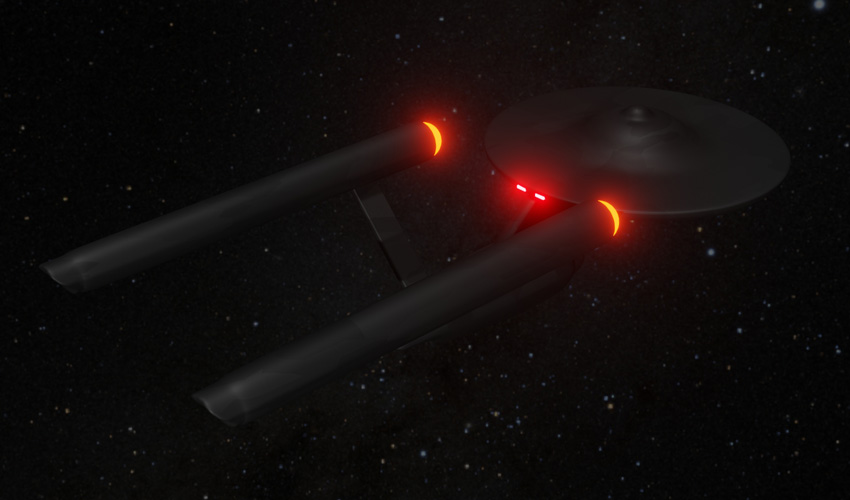
Red Uniforms: These are typically worn by crew members in engineering, security, and communications roles. Notably, Lt. Nyota Uhura and Montgomery (Scotty) Scott wore red uniforms. Wearing red on the bridge is considered a high honor. However, there’s a running joke about crew members in red shirts often meeting unfortunate fates during away missions. So, if you’re on the Starship Enterprise and want to survive, don’t wear red!
Blue Uniforms: These represent medical and science divisions. They’ve remained consistent across various “Star Trek” series. Blue shades indicate ship medics and scientific personnel.
Gold Uniforms: Worn by command officers, gold symbolizes the importance of strategic decisions. Command staff, including Captain Kirk, would wear these iconic golden shirts.
TNG, DS9 & Voyager
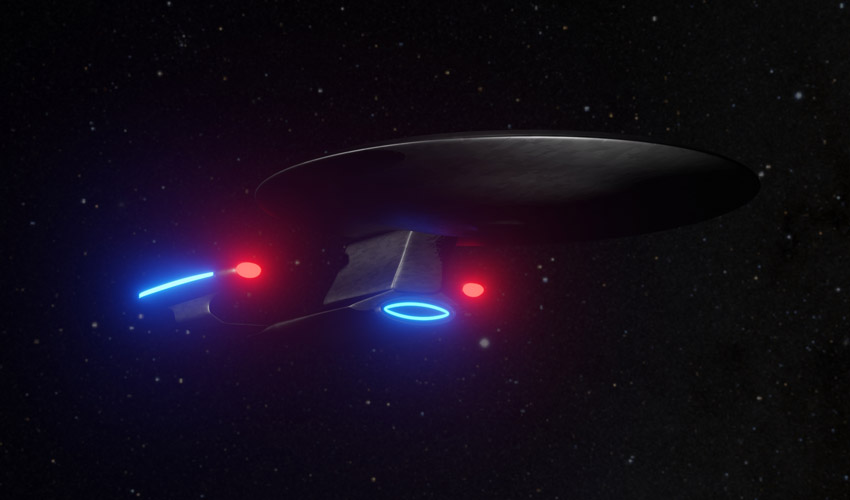
In Star Trek: The Next Generation (TNG), and beyond, not only did the uniforms modernize, the color meanings changed. Let’s delve into the significance of each uniform color:
Red Uniforms: These are worn by command staff. Captain Jean-Luc Picard and his senior officers sport these crimson hues. Red signifies leadership, decision-making, and strategic roles. If you’re in red, you’re at the helm of the starship, making critical choices for the crew and the mission.
Blue Uniforms: Medical staff wear blue. Dr. Beverly Crusher and other medical officers would have a blue uniform. This remains the same as in the original series.
Gold Uniforms: Operations and security staff wear gold. Lt. Commander Geordi La Forge, Lt. Worf, Lt. Tasha Yar, and Chief O’Brien fall into this group. Gold symbolizes efficiency, engineering, and tactical prowess. These officers keep the ship running smoothly, maintain systems, and ensure security.
In summary, the colors of Starfleet uniforms reflect the crew members’ roles and responsibilities as they explore the final frontier!
Why The Uniform Colors Change?
The switch in uniform color in the 24th century likely aimed to move away from the negative connotation associated with “redshirt” deaths, those unfortunate crew members who often met their demise during away missions.
The evolution of Starfleet’s uniform colors reflects different visions of the franchise’s costume designers over the past 50 plus years. Each new designer brings their own perspective, adapting the color meanings while honoring the legacy of this beloved sci-fi saga.
Related Colors & Posts

Similar Posts
Lightsaber color meanings.
In the world of Star Wars, the lightsaber is one of the most memorable and iconic objects within that universe. So what are the lightsaber color meanings for red, green, blue, purple and others, the weapons of the Jedi and Sith mean? Lightsabers actually get their color from what are known as kyber crystals. However,…
Use of Different Colors in Retro Games
How were colors used when it came to old retro games, why different characters had different colors? As a child I loved video games. The arcades were heaven for me as a child. I particularly found the usage of different colors fascinating in certain video games. The different colors signify different things with different meanings….
Den of Geek
Why Star Trek Uniform Colors Changed From the Original Series to Next Generation
The uniforms on Star Trek have changed over time, but for reasons that make a lot more sense behind the scenes than on the Enterprise bridge.

- Share on Facebook (opens in a new tab)
- Share on Twitter (opens in a new tab)
- Share on Linkedin (opens in a new tab)
- Share on email (opens in a new tab)
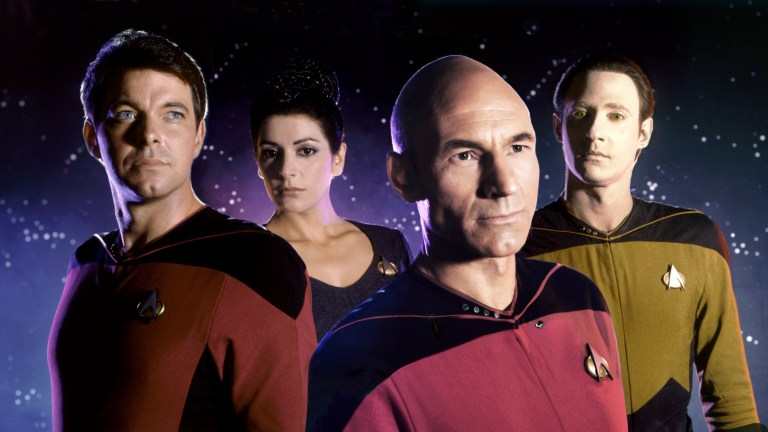
Even if you don’t know an El-Aurian from an Illyrian, even if you can’t tell the original Enterprise from the Enterprise-D, you’re probably familiar with one of the fundamental rules of Star Trek : redshirts always die.
Unlike many of the popular misconceptions about the series (Kirk doesn’t actually chase women, for example), the redshirt stereotype does have grounding in the show. Over the course of three seasons in The Original Series , 26 characters wearing red tunics died, as opposed to 15 wearing gold and blue combined. But that trend stopped with the Star Trek movies, and continued to fall away with The Next Generation and the spinoffs that followed.
Why, you ask? Because the costume colors signify a crewman’s role on their particular ship, and the color scheme changed between TOS and TNG .
Although some Trekkies hate to admit it, Star Trek didn’t really have much in the way of canon in its first few episodes. Leaving aside the infamous grinning Spock in the original pilot, it took several episodes to decide on the name of Starfleet or the Prime Directive. The same was true of the uniforms, as demonstrated by the luscious green shirt that Kirk sometimes sported.
Ad – content continues below
By the end of the series, however, the three main colors solidified into the following divisions: those in command wore gold, people such as Kirk and Sulu. Science officers and doctors, namely Spock and Bones, dressed in blue, while everyone else had red shirts. And by everyone else, that includes engineers like Scotty and security personnel, which is why they tended to get killed.
But as is so often the case with all things Trek , the uniforms weren’t entirely what creator Gene Roddenberry had in mind. Most notably, the gold uniforms were actually intended to be green, but read on camera as the color that we know today. During production of the never-released follow-up show, Star Trek: Phase II , Roddenberry wanted continuity between TOS and the new series, not only in terms of the cast, which mixed Kirk and Sulu with newcomers, but also production. In particular, Roddenberry brought back his original series costume designer William Ware Theiss.
However, when production shifted and Phase II became Star Trek: The Motion Picture , Theiss was replaced by Robert Fletcher, who designed costumes for the movie crew through Star Trek IV: The Voyage Home . Fletcher maintained some of Roddenberry’s vision for TMP , which tried to match ’70s aesthetics by giving the crew pastel pajamas. But when Nicholas Meyer took over for Star Trek II: The Wrath of Khan , Fletcher designed military-inspired uniforms to match the director’s naval warfare vision.
Although most Trekkies prefer the Meyer movies, Roddenberry hated the militarization of Starfleet and, equally important, resented the way his franchise was taken from him. So when Roddenberry regained some power for The Next Generation , he sought to right the ship, so to speak, by making Starfleet explorers again. And with it, he brought back Theiss.
For the most part, Theiss succeeded where Roddenberry and Fletcher failed in TMP . The TNG uniforms feel like ’80s versions of the ’60s original, especially after they were revised in season 3. However, with the emphasis on division colors came a confusing switch. Once again, science officers and doctors wore blue, but command now wore red while operations wore gold. Also, there’s the skant, but only Lower Decks talks about that now.
So why did the colors change? Once again, the answer is simple and almost mundane. Patrick Stewart apparently didn’t look commanding enough in yellow, while Brent Spiner , in his pale Data makeup, didn’t look good in red.
Roddenberry and the producers may have also been amenable to these changes because of the public’s changing perception of the aesthetic of Star Trek at the time. It was the massive success of Star Trek IV that gave Roddenberry the green light for TNG , and in that movie the crew wore the same civilian clothes that they sported in The Search for Spock , but during the first three Trek movies, Kirk wore red (as did Spock and the rest of the crew, because everyone wore red in Meyers’ more militarized uniforms).
Get the best of Den of Geek delivered right to your inbox!
So in the eyes of casual fans, the Captain wore red. And even Trekkies had seen enough of Kirk in red that the idea didn’t seem outlandish.
The Trek uniforms have been altered many times since. TNG and Deep Space Nine later limited colors to the shoulders, a look continued in Voyager . The TNG movies then introduced darker uniforms in Star Trek: First Contact , with division colors on the underliner, a look adopted by later seasons of Deep Space Nine .
These stories adhere to the division colors from TNG , but whenever the franchise goes back to pre- TNG era — including the J.J. Abrams reboot movies or Strange New Worlds — the TOS colors come back into play. Even the prequel series Enterprise , in which the crew of the NX-01 wears blue jumpsuits with TOS division colors on the piping. And then there’s Discovery , which began with blue uniforms and a different division color scheme, but that show started out as its own thing, anyway.
Rest assured, writers both official and on the internet have offered in-Universe explanations for the evolution of the costumes. But the best explanation is that Star Trek , as an ongoing story over six decades old, had evolved and mutated over the years, sometimes in ways that don’t make sense. And as long as some unnamed operations ensign gets killed now and again, that’s just fine.

Joe George | @jageorgeii
Joe George’s writing has appeared at Slate, Polygon, Tor.com, and elsewhere!
- Celebrities
- Secret Invasion
- The Marvels
- Disney Plus
- Apple TV Plus
- Dwayne Johnson
- Brie Larson
- Ryan Reynolds
- The Witcher
- About & Advertising
- Privacy Policy
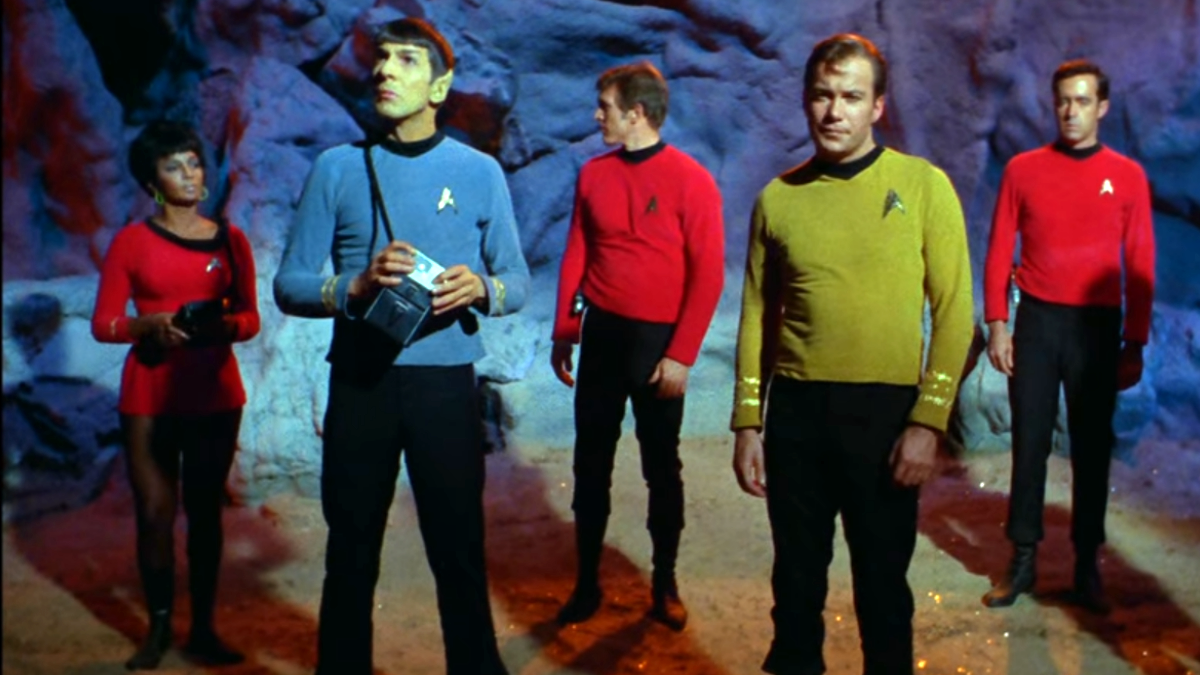
‘Star Trek’ uniform colors, explained
Everyone knows the iconic Star Trek uniforms. The brightly-colored outfits amazed viewers seeing color TV for the first time in the 1960s and helped to define the unique aesthetic style of the Star Trek universe, becoming an instantly recognizable feature of the shows.
The 23rd Century
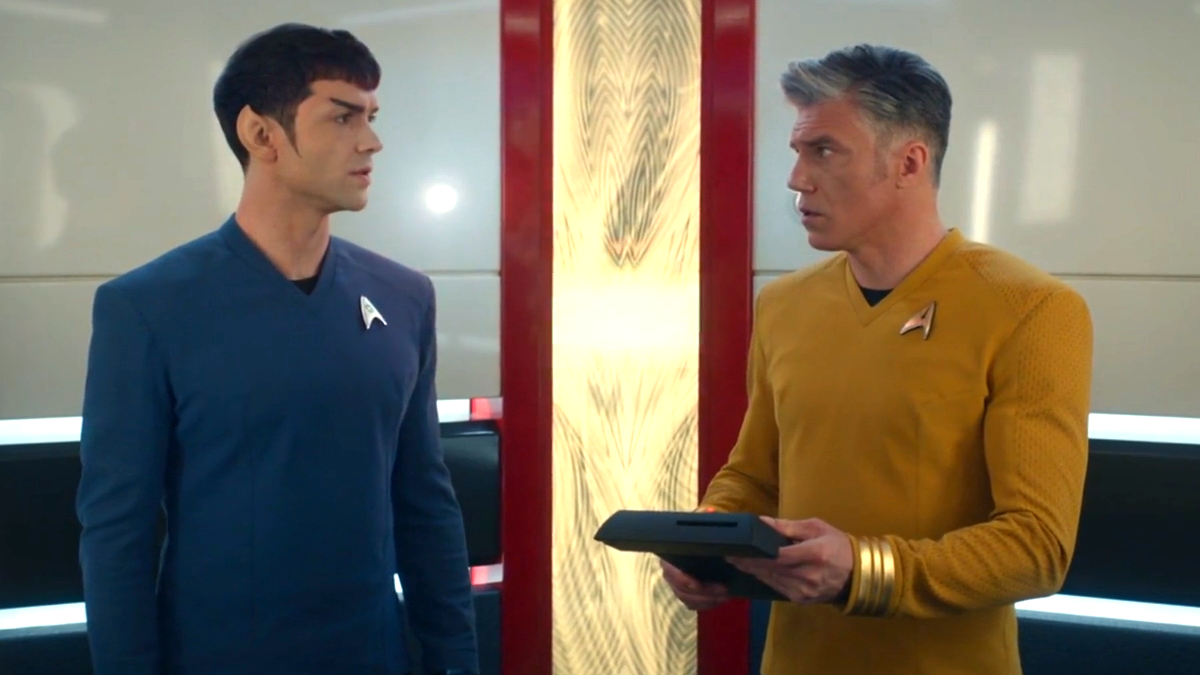
In The Original Series , there were three uniform colors . Each color represented a certain duty division aboard a starship or station. Gold, as worn by Kirk and Sulu, denoted the command division of Starfleet, which included most ranking officers and administrative personnel. Blue, as worn by Spock and McCoy, denoted the sciences division. This included researchers and medical staff. Red, as worn by Uhura and Scotty, denoted the operations division which covered a wide range of specializations such as engineering and security. Each color choice was bold and striking, meaning viewers could immediately tell what position any new character had in Starfleet.
The Original Series gave rise to the infamous phenomenon of “redshirts.” Security officers wore red shirts and would regularly put themselves in harm’s way. Enterprise crew clad in red were massively more likely to be killed than their counterparts in the other divisions. A redshirt’s life could be painful and short — they would be blown up by alien weaponry, plunge head-first into bottomless chasms, or even have all their red blood cells surgically removed by malevolent cloud creatures. Around 26 officers in red uniforms died during the course of the series’ three-year run. In the season two episode “ The Apple ,” four unfortunate redshirts are killed navigating a jungle deathtrap, being struck by lightning, shot by plants, and falling onto landmines. Even by the cruel standards of the show, this ranks as a bloodbath.
Strange New Worlds — set very shortly before The Original Series — keeps the same uniform colors, but adds a new one. A white uniform denotes someone working as a member of medical staff, but these were seemingly phased out in favor of standard blue uniforms by the time of The Original Series .
Star Trek: Discovery , a prequel series set a little further prior to The Original Series , introduced a new color-coding system. All uniforms were made of dark blue fabric, with division denoted by metallic stripes on the shoulders. These stripes were gold (command), silver (sciences), and copper (operations). These clothes were super-sleek but looked too much like Navy uniforms, and it could be hard to tell at a glance who was part of what division.
The 24th Century
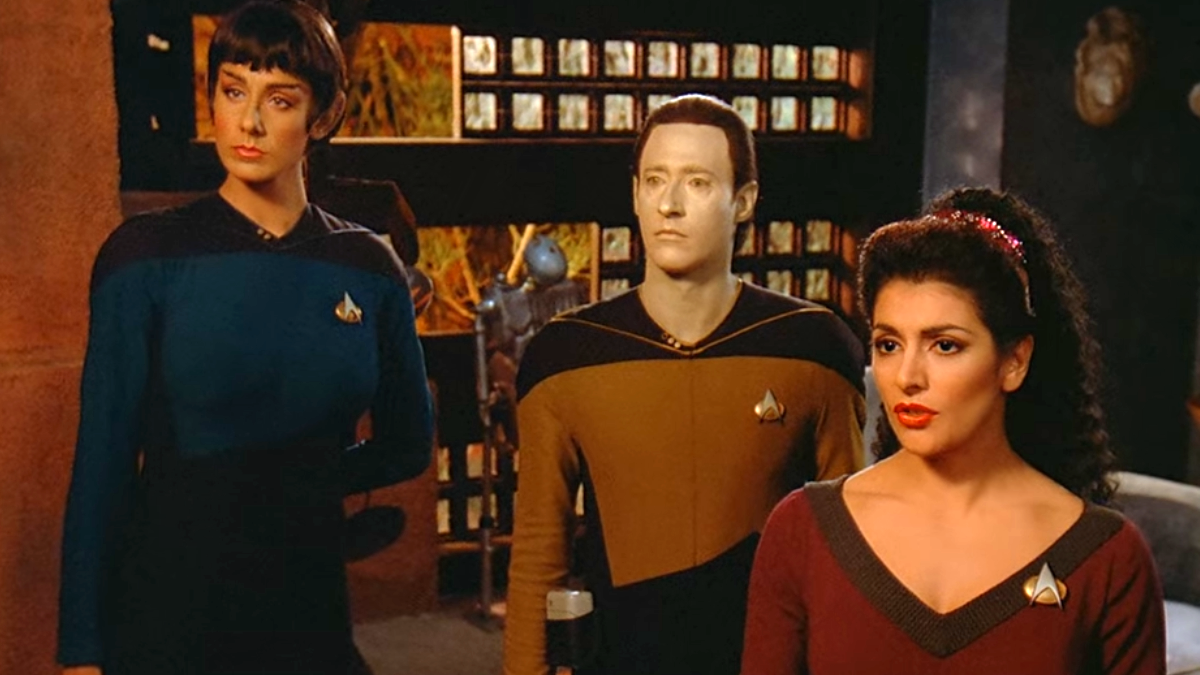
By The Next Generation , the uniform colors had changed . While blue still denoted science and medical, the meanings of red and gold were inverted. No reason was ever given in-universe for this, but the real-world explanation is that Next Generation actors looked better in certain colors — Brent Spiner as Data, for example, was deemed to look far better in gold than in red or blue. The change also came partly as a result of the Star Trek movies of the 1980s, where all Starfleet personnel were shown to wear red uniforms (the fabric for the costumes took better to red dye). Kirk had been seen wearing red for the movies, so it was felt that audiences would come to associate red with command.
Whatever the century, series, or ship, Star Trek just wouldn’t be the same without everyone clad in brightly colored pajamas. Too many modern science fiction shows have their actors wear drab, dark, soulless uniforms. Strange New World s is proudly carrying on the multi-colored tradition set way back in 1966.
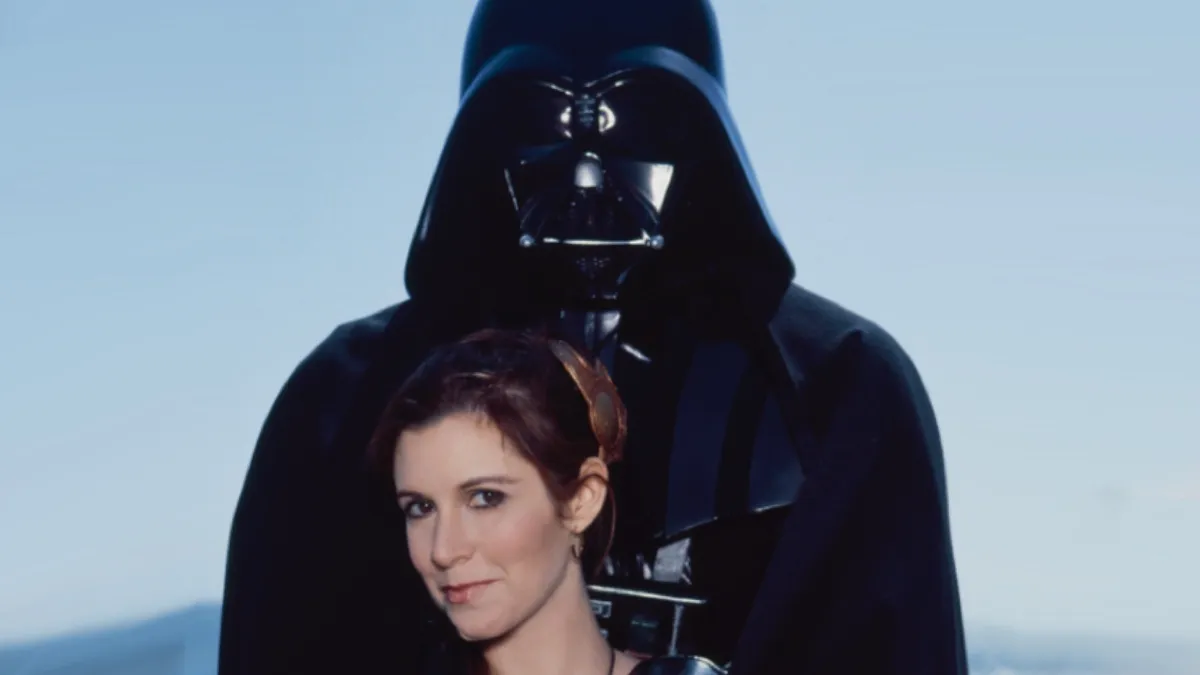

Starfleet uniform
- View history

Starfleet uniforms in 2371, showing two separate styles in use at once
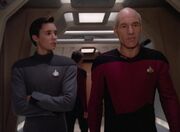
A provisional officer's uniform alongside a standard duty uniform
Starfleet uniforms were uniforms worn by individuals serving in the Federation Starfleet , originally a United Earth organization. These uniforms facilitated the wearers' needs as both scientists and researchers , as well as Starfleet's military role. The uniform and combadge used by Starfleet personnel may vary by the ship or facility they were assigned to, or the officer's rank or department. These were often retained even when visiting other Federation locations. ( TNG : " The Child "; DS9 : " Homefront ", " Tears of the Prophets "; LD : " We'll Always Have Tom Paris ", " Kayshon, His Eyes Open "; DIS : " Saints of Imperfection ")
Casual duty attire also allowed for considerable variation of uniform aboard a Starfleet vessel, though it was ultimately up to the captain's discretion. Wearers were expected to abide by the Starfleet dress code , though special exceptions were sometimes made for certain aspects of an individual's cultural heritage, such as Worf 's Klingon baldric , Nog 's Ferengi headdress , and the earrings of Ro Laren , Kira Nerys , and Shaxs . ( VOY : " Learning Curve ", et al.) According to Elim Garak , " I think Starfleet should allow their officers more latitude in accessorizing their uniforms. You'd be surprised what a nice scarf can do. " ( DS9 : " Broken Link ")
On two occasions, the term " Federation uniform " was used to describe Starfleet uniforms.
In 2369 , the Bajoran civilian Mullibok , who was being evicted from his home , asked Commander Benjamin Sisko how many Federation uniforms he planned on sending down to have him removed. ( DS9 : " Progress ")
In 2372 , Chakotay referred to his as a Federation uniform as he explained to Kar how it was like the Jal name that the Kazon earned. Chakotay told him that his uniform was earned through " years of study ", and " learning about science and ships and navigation , " adding too, that he was further taught to be "[..] prepared us to defend ourselves in battle. They prepared us very well. And we had to pass many difficult tests before we were given the right to wear the uniform. " ( VOY : " Initiations ")
- 1.1 Command
- 1.2 Operations
- 1.3 Sciences
- 2.1.1 Type #1
- 2.1.2 Type #2
- 2.1.3 Type #3
- 2.1.4 Type #4
- 3 Uniform variations
- 4 Dress uniforms
- 5.1.1 Design
- 5.2 Ambiguous uniform
- 5.3 External links
Divisions [ ]
Starfleet uniforms were classified by color among the command, sciences, and operations divisions. Occasionally, the uniforms were also broken down by department, while displaying rank insignia conspicuously. The color scheme had varied over time throughout Starfleet history, but the uniforms were designed for comfort even in the most extreme environments. ( DS9 : " Trials and Tribble-ations ", " Let He Who Is Without Sin... ")
Command [ ]
The command division was the head of Starfleet, with most of the ranking officers in Starfleet Command wearing these colors. Generally, this division was responsible for the administration of starships , starbases , and space stations .
Operations [ ]
The operations division was the backbone of Starfleet, encompassing the engineering , security , and support departments. This division was responsible for technological innovation and for maintaining and defending the Federation.
Sciences [ ]
The sciences division was the heart of Starfleet, composed of the exploratory , medical , and mental health departments.
Uniform styles [ ]
Unknown eras [ ].
These Starfleet uniforms were introduced between the 24th and 31st centuries .
Type #1 [ ]

A female officer in an unknown uniform
This uniform was worn by an operations division officer , as seen in a photo within the Transporter Facility maintained by Chief Petty Officer Carlton Dennis . ( LD : " Grounded ")
Type #2 [ ]
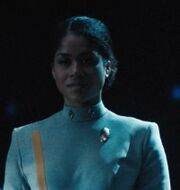
A female junior officer in a uniform from an unknown era
This uniform was worn by one of Tal 's hosts . ( DIS : " Forget Me Not ")
Type #3 [ ]
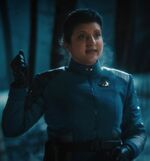
A holographic representation of a female lieutenant
This uniform was worn by officers in an unknown era. ( DIS : " Su'Kal ")
Type #4 [ ]
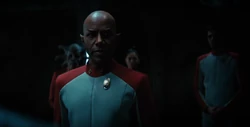
Holographic representations of officers in uniforms from an unknown era
This uniform was worn by the delegation welcoming the Kelpien and Ba'ul Alliance into the Federation. ( DIS : " Su'Kal ")
In the 23rd century , similar uniforms had been in use as cadet outfits. ( DIS : " Through the Valley of Shadows ")

Uniform variations [ ]
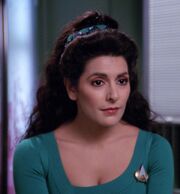
Troi in her casual attire
Some officers wore alternate uniforms. Deanna Troi often wore casual clothing while on duty, and T'Pol retained her original Vulcan uniform with a few concessions to her Starfleet rank and ship assignment. Other officers, such as Worf, Montgomery Scott , and Ro Laren, were allowed to wear accessories relating to their culture with their uniforms, but this was at the discretion of the captain. Uniforms were also altered to accommodate non-humanoid officers, such as the three-armed, three-legged uniform of the Edosian Arex , and the uniforms for beluga whales Kimolu and Matt . ( ENT : " Borderland "; Star Trek II: The Wrath of Khan ; TNG : " Ensign Ro "; TAS : " Mudd's Passion "; LD : " First First Contact ")
Uniforms were also adapted to environmental or atmospheric conditions. When exploring the planet Tyree , Benjamin Sisko and colleagues wore long, flowing gown uniforms to deal with the sand . They featured a colored stripe to represent departments. ( DS9 : " Shadows and Symbols ")
Dress uniforms [ ]
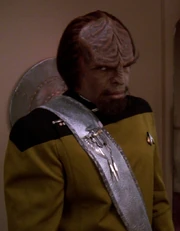
Worf wearing his dress uniform with a Klingon ceremonial sash
Dress uniforms were a variant of the standard Starfleet uniforms worn for special occasions, such as weddings , courts martial , funerals , and the greeting of ambassadorial delegations and heads of state. ( TOS : " Court Martial ", " Journey to Babel "; TNG : " Lonely Among Us ", " Manhunt ", " Data's Day "; DS9 : " Move Along Home ", " Rules of Engagement "; VOY : " Course: Oblivion ", " One Small Step ", " Ashes to Ashes "; Star Trek: Insurrection )
Appendices [ ]
Background information [ ].
Patrick Stewart 's character of Jean-Luc Picard has appeared in more styles of Starfleet uniform than any other character on screen without story contrivances (like time travel , holodecks , or alternate timelines ) being involved.
For most of Star Trek 's history, Starfleet uniforms have had at least three division colors. Some characters have worn different division colors in different episodes. Leslie , Jae , Tom Paris , Harry Kim , and Sylvia Tilly have each been shown wearing three colors at different points (including, for Paris and Kim, alternate timelines and holodeck scenarios); however, the first character to wear all three division colors in one episode was Ensign Sam Rutherford , who wore operations gold, command red, and medical blue in LD : " Envoys ".
The Starfleet uniforms worn during Star Trek: The Original Series were designed by William Ware Theiss , who returned to design the Star Trek: The Next Generation uniforms (which were further adapted into future versions on Star Trek: Deep Space Nine , Star Trek: Voyager , and the TNG -era films by Robert Blackman ). Robert Fletcher designed the uniforms seen throughout the original series movies, with later new designs provided by Nilo Rodis .
Robert Blackman also designed uniforms worn on Star Trek: Enterprise , a design representing a precursor to those seen in TOS . The uniforms seen in Star Trek: Discovery were designed by Gersha Phillips . The uniforms in Star Trek: Picard were designed by Christine Clark .
Michael Kaplan designed the uniforms seen in Star Trek and Star Trek Into Darkness , and Sanja Hays designed the uniforms for Star Trek Beyond .
As shown in the It's A Wrap! sale and auction , a number of Starfleet uniforms have had padding to increase muscular appearance. Such cases include two costumes for Tom Paris , one racquetball costume for Julian Bashir , and a Deep Space Nine costume for Worf, to create a more Klingon appearance. According to Wil Wheaton , all the main cast members wore muscle padding during the first two seasons of The Next Generation , mainly because of the tight-fitting nature of the spandex uniforms used in these two seasons. [2]
Several prototype uniform undershirts to those seen in Star Trek II: The Wrath of Khan on were sold off on the It's A Wrap! sale and auction on eBay. [3]
Ambiguous uniform [ ]
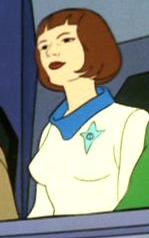
Female on the Elysian Council
A Human female seen as a member of the Elysian Council in " The Time Trap " wore a uniform of ambiguous origin. It was described in the Star Trek Concordance as "a white suit with blue collar and an insignia on the left breast," and was suggested to "possibly [be] an early Star Fleet [sic] uniform". While it is known that the Bonaventure , and possibly other Earth/Federation ships, were lost in the years prior to 2269, it is unclear if this is indeed a Starfleet uniform, and, if so, from which era it originated.
External links [ ]
- Starfleet uniform at Memory Beta , the wiki for licensed Star Trek works
- 22nd & 23rd century Starfleet uniforms at Ex Astris Scientia
- 24th century Starfleet uniforms at Ex Astris Scientia
- Starfleet uniforms at Spike's Star Trek Page
- Interview with William Ware Theiss at Phaser Resource (X)

- [ April 25, 2024 ] 18 Ron Swanson Quotes that Know What They’re About Articles
- [ April 24, 2024 ] The Detroit Youth Choir is Coming to SporcleCon! Articles
- [ April 23, 2024 ] Partner Spotlight: TD’s Tailgate in North Canton, OH Sporcle Events
- [ April 23, 2024 ] Partner Spotlight: Barkyard n’ Brews in Fort Lauderdale, FL Sporcle Events
- [ April 23, 2024 ] Partner Spotlight: Union Rec in Ann Arbor, MI Sporcle Events
Star Trek Uniform Colors – What Do They Mean?
Space…the final frontier.
In 1964, Gene Roddenberry pitched his idea for a space-age Western to NBC. His hope was to create a science fiction series that was like “Wagon Train to the stars,” but he also wanted the show’s content to reflect some of the very real problems that were plaguing Earth at the time. He felt the show had the potential to provide viewers with a realistic glimpse into a more utopian society, one which he thought was possible for humanity if they could learn some lessons from the past.
In 1966, his vision came to fruition when Star Trek first hit the airwaves. Over time, the show would go on to earn high praise for its cultural influence. The Original Series featured one of TVs first multiracial casts, one that also portrayed women in working roles, and many have cited Star Trek as being the inspiration, at least in part, to some of the technologies we have today, like cell phones and computer tablets. We even have a new way of speaking to each other thanks to Star Trek with the creation of Klingon , the world’s most popular fictional language.
The attention to detail Roddenberry brought to creating his fictional universe was immense, and while he may have helped inspire the iPad, not everything from Star Trek has caught on just yet. Apparently, his vision of a more utopian future also included velour tops, spandex jumpsuits and plastic. Something tells us we still have a ways to go before we start seeing fashion models walking down the catwalk dressed like Worf.
While the Star Trek uniform colors might seem highly illogical , that doesn’t mean they actually lacked that same awareness Roddenberry used elsewhere in the series. In fact, a lot of thought went into the costume design. The colors and insignia on each uniform can actually be quite telling.
It turns out there is a reason you should avoid wearing a red shirt during exploration missions.
To Boldly Go Where No Costume Designer Has Gone Before
To stay in line with his vision of a realistic future, Roddenberry wanted crew members of the Enterprise, the fictional star-ship of the series, to have realistic jobs and job titles. They used the US Navy as a guide, creating comparable ranks and job structures. There was a commander, a handful of lieutenant commanders, lieutenants, and numerous other roles. The various positions were eventually learned by viewers throughout the course of the show, but it was the uniform colors that gave the real hints as to who does what on Enterprise.
The Starfleet did not have randomly assigned uniform colors. Each color actually represented one of the ship’s various jobs and service roles. Here’s a quick breakdown on the Star Trek uniform colors from the Original Series:
- The command division wore gold shirts. This includes Captain Kirk, Lieutenant Sulu, and Pavel Chekov.
- The science and medical staff wore blue shirts. This includes Lieutenant Commander McCoy and Commander Spock.
- The engineering and communications division wore red shirts. This included Chief Engineer Scotty and Communications Officer Uhura.
- The security division also wore red shirts. You might know these people as the careless supporting characters that are immediately killed whenever the crew is confronted by a new enemy. We told you to avoid them.
This all gets a little messy in later Star Trek series. In The Next Generation, for example, command staff wore red and it was the engineering and security staff that wore yellow. Each new Star Trek movie that comes out further complicates things. Costume colors switch in almost every new adaptation.
Sleeve stripes highlighted the rank of crew members. The meaning of these has also changed throughout the course of the franchise. Generally speaking, the more stripes one had on their sleeve, the higher ranking they were. So captains often wore two or three stripes, while other enlisted officers might only have a single stripe.
Gold Is The New Green
Now for the really confusing part. Remember how Captain Kirk and crew wore those gold command shirts?
The Star Trek uniform colors were originally supposed to be red, blue and green. If you pay close attention, you’ll see this was the case. Captain Kirk’s outfit was actually more of a lime green when he was on set, but under bright studio lights, it appeared gold on film. As Star Trek costume designer William Theiss describes , “It was one of those film stock things. It photographed one way – burnt orange or a gold. But in reality was another; the command shirts were definitely green.”
Despite gold being canonized in later show dialog, when the lights are off, Kirk definitely shows his true colors.
Regardless of what color they were, one has to respect the vision and contributions that Star Trek has brought to the science fiction genre. Gene Roddenberry wanted everything in his fictional universe to have a specific purpose. While the series has had it’s share of highs and lows, one has to respect the attention to detail given. Just hope you never find yourself stuck wearing one of those red shirts.
About the Author:

Mark Heald is the Managing Editor of Sporcle.com. He enjoys spending time with his family, traveling, and bemoaning the fact the Sonics left Seattle.
- Mark Heald https://www.sporcle.com/blog/author/markh/ Why Do April Showers Bring May Flowers?
- Mark Heald https://www.sporcle.com/blog/author/markh/ Sporcle 2023 Year in Review
- Mark Heald https://www.sporcle.com/blog/author/markh/ Countdown to Five Billion: Wrap-Up
- Mark Heald https://www.sporcle.com/blog/author/markh/ Where Do Sporcle Events Questions Come From?
Related Articles

Why Do Players Wear White at Wimbledon?
(Last Updated On: June 28, 2022) Each summer, people from all around the world tune in to watch one of the most famous tennis championships of all time. The Championships, Wimbledon, usually referred to simply […]

What Are the Stranger Things Monsters From?
(Last Updated On: July 3, 2022) Watching Stranger Things you probably see this question and go “well obviously it’s just Dungeons & Dragons.” Which is true, but unless you play the tabletop game names like […]

20 Schitt’s Creek Trivia Team Names
(Last Updated On: June 23, 2020)Who hasn’t purchased a small Canadian town as a joke and then had to move there because they lost all their money? Well, the Roses of Schitt’s Creek most certainly […]
Copyright © 2007-2024 Sporcle, Inc.
The Long History of Star Trek Uniform Fashions
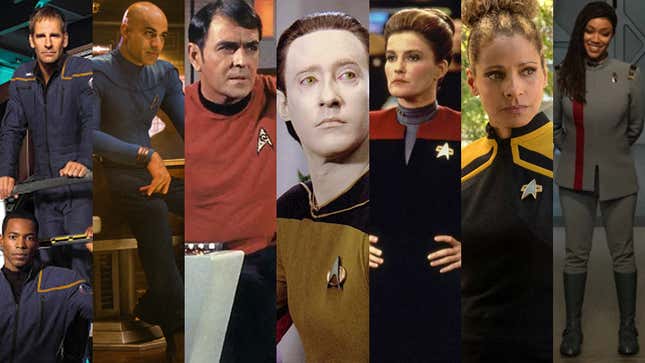
The debate over whether or not Starfleet is a military organization, a scientific one, or a messy, often contradictory combination of both has been a part of Star Trek since it began. One thing that we can always be certain of though? It loves a wardrobe shakeup . With Discovery ’s upcoming season adding yet another uniform, here’s a look at four centuries (give or take an eight-century gap along the way) of Star Trek fashion.
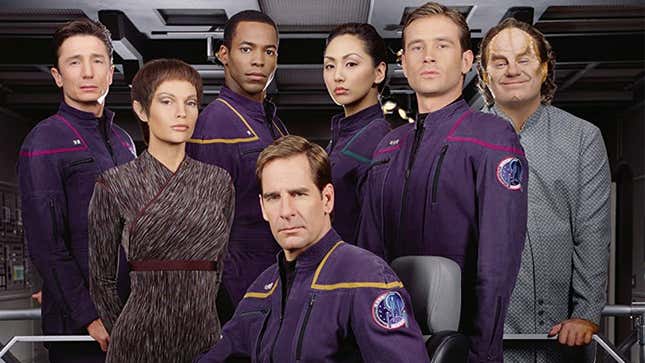
Enterprise may have been one of the more recent Treks , but it gave us our earliest possible look at Starfleet fashion, in the years leading up to the Federation’s founding. These blue jumpsuits might feel like a precursor to what’s to come, but the thin shoulder straps of colors for Command, Operations, and Science divisions would rotate in and out of Starfleet for centuries to come.
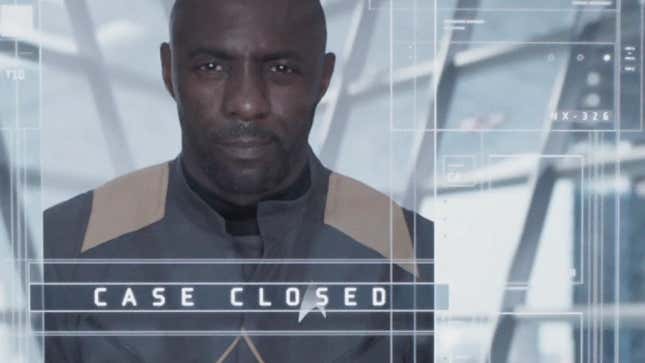
Star Trek: Beyond might take place in an alternate universe, but because its story briefly touches on the ancient mission of Idris Elba’s Captain Edison (who eventually gets transformed into the villainous Krall), the uniforms depicted there are actually from before the moment the “prime” Trek universe splits into the “Kelvin” timeline, making them an evolution canonical to Enterprise and beyond. These draw a lot of inspiration from Enterprise ’s uniforms, with the blue jumpsuit now grey and the division color swatches significantly larger.
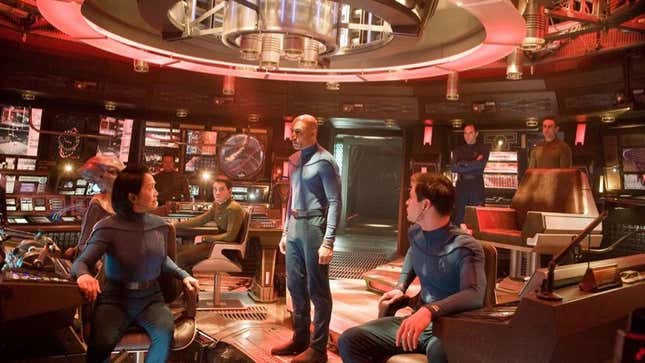
The same goes for the uniforms seen on the U.S.S. Kelvin in the opening of the 2009 Star Trek reboot —these were the uniforms being worn at the point of the timeline split, making them a part of both Trek timeline’s histories. A much more radical break from the century before, these replaced jumpsuits with universal black pants and a colored long sleeve shirt: dark blue for Command, dark gold for Operations, and grey for Sciences.
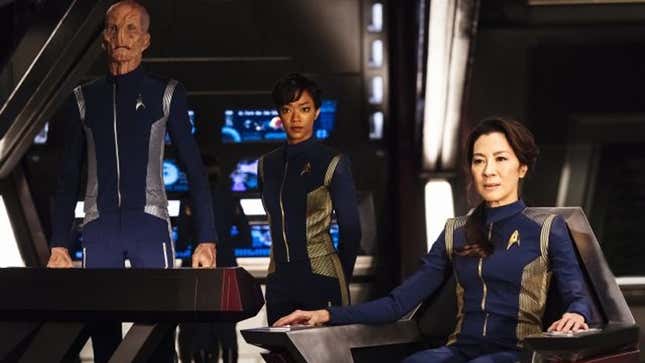
At this moment in history, whoever’s in Starfleet costuming just had a bunch of ideas they wanted throwing out, presumably much to the chagrin of the poor officers who had to update their wardrobes multiple times in the next few decades. First up, this retro throwback to the blue jumpsuits of the earliest days of Starfleet, this time in a two-piece uniform, but with a major change: division colors saw an overhaul in a similar vein to the uniforms immediately preceding this look. Gold became the color for Command, with metallic bronzes and silvers for Operations and Sciences, respectively.
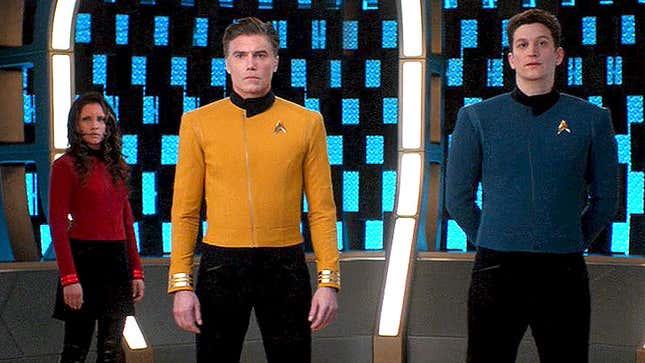
Shortly after the Klingon-Federation war, Starfleet was in the process of sending out a second updated division color change, because the best time for sweeping updates is just as you’re recovering from a nearly devastating intergalactic war. Maintaining the suits of the 2230s design, these introduced bold new color schemes in place of the navy blue and metallics: black trousers and skirts for the first time, matched with jackets that predominantly featured the classic, bright yellow for Command, Red for Operations, and a navy blue for Sciences.
Late 2250s, Type A

INT. Starfleet Command, Wardrobe Design Division
Officer: We just sent out the new color division jackets to the flagships, is it really necessary to have such a radical overhaul so soon?
Designer: Yes, it’s how I get paid. Everyone wears jumpers now! And we love beige, beige is very in on Vulcan right now.
Officer: Hang on, we’re keeping the gold and the blue and adding beige, won’t that be difficult to differentiate?
Designer: No one cares, those nerds are down in Engineering and never on the bridge. Also, the blue is baby blue now, the dark blue clashes too much.
Officer: Sure, fine, what—wait, hang on, you get paid for this? We live in a post-scarcity society!
Designers: ASKING QUESTIONS DOESN’T SOUND LIKE SENDING NEW UNIFORM DESIGNS TO THE REPLICATORS, ENSIGN.
Late 2250s, Type B

INT. Starfleet Command, Wardrobe Design Division, Three Days Later
Officer: You changed your mind.
Designer: I changed my mind. It was foolish to follow Vulcan fashion trends, and I miss my colors. We’re back, baby, let’s get that red in there!
Officer: Okay, I’ll get these recalled by Command in the hour, any schematics that have gone out to the flagships will have to be withdraw—
Designer: Oh, but the jumpers.
Officer: I’m sorry?
Designer: The jumpers are good! Let’s keep them. Oh, and the ladies get miniskirts now. Lovely. I have all this fabric that needs using up and we can’t just go back to the jackets.
Officer: That’s not how replicators wor—
Designer: JUMPERS, ENSIGN.
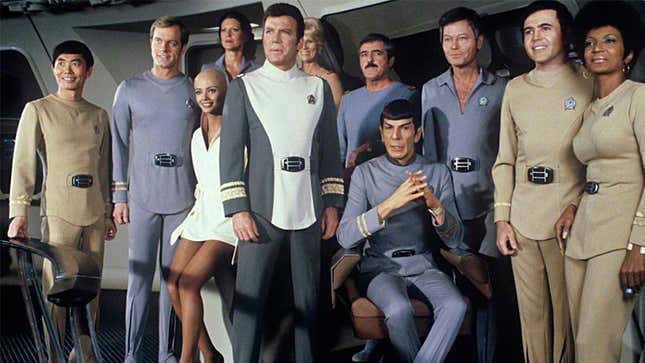
It’d take another decade-plus, but Starfleet merrily marched back into the land of beige with this highly customizable variant. Robbing the divisions of much in the way of color difference—there were variants in white, beige, and grey, and they were non-division specific—these uniforms had a wide arrange of alternates. They could come as one-piece jumpsuits or two-part trousers and tunics, they could have standard, high-necked, or flared collars, medical and operations officers even had the option to have a wide-collared wraparound tunic for good measure instead. Probably to make up for a lack of color!

Fast-forwarding an entire generation, the Starfleet of TNG ’s era decided to go back to big, bold colors—and a lot of black accents. The classic colors returned, but which division got them changed: red was now the color of Command, gold for Operations, and blue for Science. While this style of uniform would persist for two decades, it did feature some updates over that period that evolved, but didn’t outright replace the original design: most notably there was the transition from a one-piece jumpsuit to a two-piece collared jacket and trousers, but it also introduced a gender-neutral miniskirt option called the “Skant” .

This itself has a lot of similarities to the evolved 2350s look, but instead of division colors taking up the majority of the arms and torso, they were relocated to the shoulders. Instead of the continuing collar on the jacket for rank insignias, these uniforms added a grey, high-necked undershirt that would have rank pips displayed on it. It’s also here you begin to see more of a delineation in the Science and Medical-specific division colors, with the blue slowly being replaced with a sea-green reminiscent of the early Sciences uniforms.

Never let it be said that something like an existentially threatening war got in the way of Starfleet fashion. Just as the Dominion War was breaking out, Starfleet once again issued an updated uniform design, borrowing heavily from the jacketed uniforms of the 2350s and ‘70s. There were some major twists though, primarily in the jackets: division-specific shoulder patches were replaced with two-toned, padded black-and-grey variants, with the grey undershirts now being swapped to reflect the division colors.
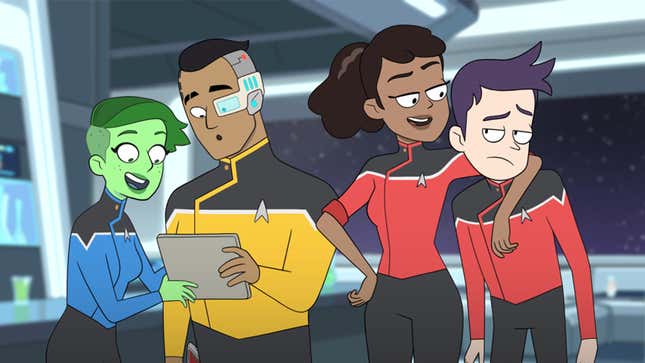
After two decades of a similar design ethos, Starfleet went into a much more animated overhaul here. Double-breasted tunics replaced the prior jackets, and now their colors were once again more evocative of the original 2350s designs: predominant use of division color on the arms and torsos, broken up by black shoulders and collars. Further breaking up the divide between black and division color this time however was a white band cutting across the arms and chests, carving out the “classic” shape of prior uniforms.
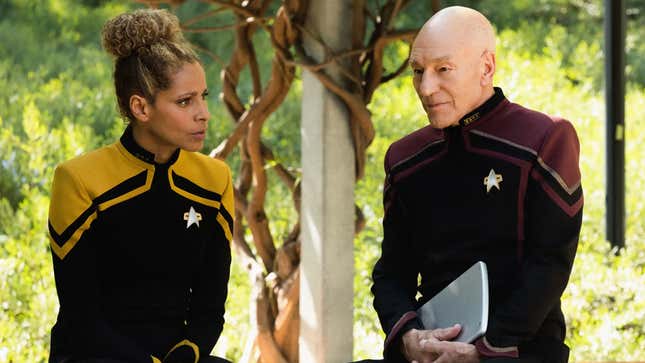
Someone at Starfleet Design couldn’t make their mind up though, and by the end of the decade we were back to colored shoulders, evocative of the decade’s previous design in shape, but now broken up across the torso and neck area. The jackets were lengthened across genders, too, creating a more dress-uniform look.
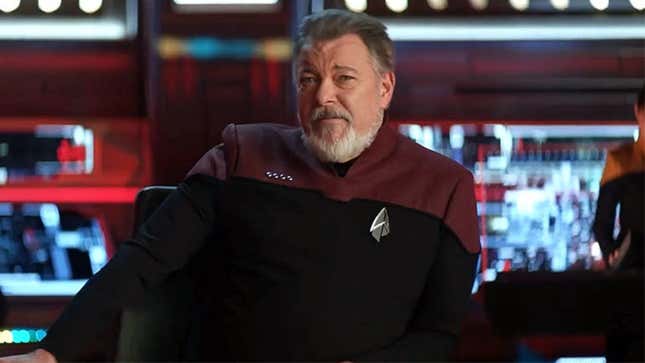
This period was apparently what one might describe as a wave of 2360s nostalgia, because this uniform update feels very much evocative of that period, albeit with some small design tweaks. The grey undershirt is now a solid black, while the colored division shoulder pads—featuring a subtle hexagonal design for texture—now extend to include a collar over it, and rank pips displayed on the chest rather than the neck.

Fast forward nearly eight hundred years , and we get to miss out on an awful lot of Starfleet uniforms. But we do get a glimpse of the very futuristic fashion of the 32nd Century in Discovery , and the future is...very grey. The most businesslike of all the uniforms we’ve seen so far, this tunic maintained division delineation through a large stripe running vertically down an officer’s right side—now adding specifically white for Medical personnel, on top of the red, gold, and blue for Command, Operations, and Science.
Interestingly enough, security officers, usually roped in with Ops, get their own uniform variant, presumably because tactical maneuvers in a bulky suit were annoying. Featuring a dark blue honeycomb-padded section across the arms and upper torso, this variant was filled out with a similarly grey-toned jumpsuit.
3180s, Type B
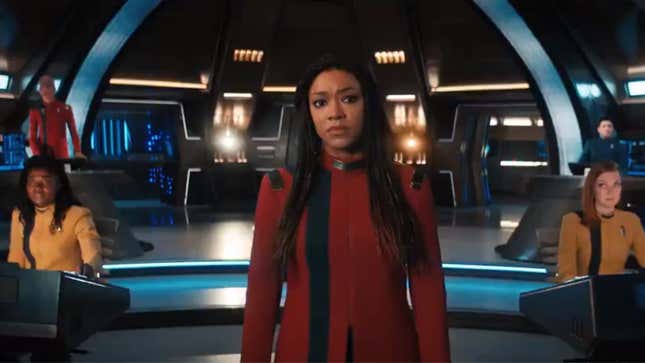
Last week’s Discovery season four trailer, meanwhile, gave us a much brighter variant on the uniforms, while also evoking the classic 2250s Type B design. The previous suit jackets remained, except now they were predominantly based on division colors—the former “stripe” now being black, with trousers to match.
Since we’ve not seen the season yet, it’s hard to say if these replace the other uniform entirely or are actually used on starships compared to Federation HQ—and how long they’ll last remains to be seen. But Star Trek history tells us that there’s always a wardrobe update just around the corner, so don’t be surprised to boldly go back into the wardrobe soon enough.
For more, make sure you’re following us on our Instagram @ io9dotcom .
- Movies & TV
- Big on the Internet
- About Us & Contact
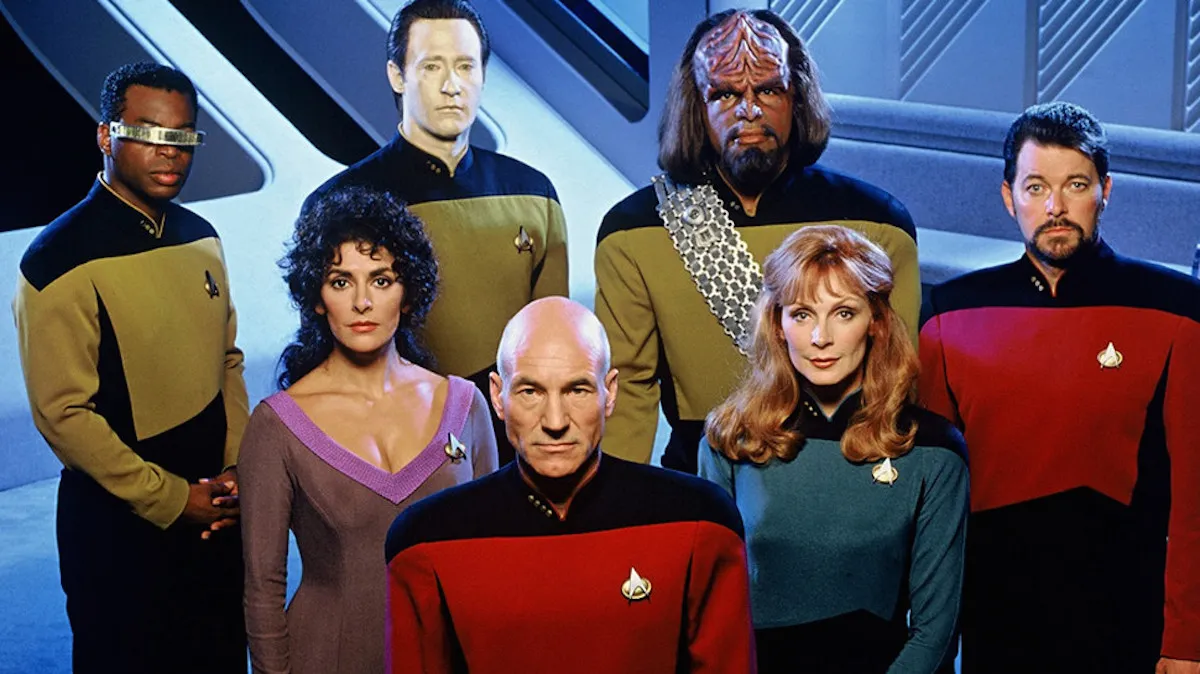
A Guide to the Different Uniform Colors the Characters Wear in ‘Star Trek’
Star Trek: The Original Series premiered in 1966. And in the year 2022, the franchise doesn’t seem to be slowing down soon. Currently, there are several ongoing television series with a new film and series recently announced.
I was a toddler when Star Trek: The Next Generation came out in 1987, making Picard’s Enterprise crew one of my earliest memories. I still love the series (as I sip out of my Chateau Picard wine tumbler). But the meaning of their uniform shirts eluded me for the longest time. Honestly, I thought you just picked your favorite color outfit when you joined a crew. After the “redshirt” trope (where a redshirt team member was more likely to die on a Star Trek away mission) became known, I thought there might be more to it. Apparently, there is a whole color-coded system in place. And the meaning of the colors changed slightly through the various shows.
The Original Series
For the original Star Trek series and the Enterprise prequel that came later, the uniform color breakdowns are:
Red – Engineering, Security, and Communications
Blue – Science and Medical Staff
Gold – Command Staff
Green – Command Staff Formal
The original series is where the redshirt trope comes from. It always seemed like if a random character in a red shirt went on an away mission, then they were not making it back to the ship. The largest group of people wore red uniform shirts, which would make it more likely that a person who died or got injured would have a red shirt on.
The Next Generation
When The Next Generation arrived, the series changed several things from the original, including the uniform colors:
Red – Command Staff
Gold – Operations and Security Staff
TNG , more so than the original series, set the template for most future shows. Even though the uniform styles changed, the color classifications stayed the same in Deep Space Nine , Voyager , Discovery , Picard , and the animated show Below Decks .
However, every season contained at least one character who wore their own take on the uniform that did not line up with the standard Starfleet look. Examples being: Deanna Troi from TNG (to relate to her patients better), Odo and Kira Nerys from Deep Space Nine (because of their connection to the Bajoran military), and Seven of Nine in Voyager (because of her cyborg physiology).
Now that we are clear on which uniform color means what, which color would you pick?
(feature image: Paramount)
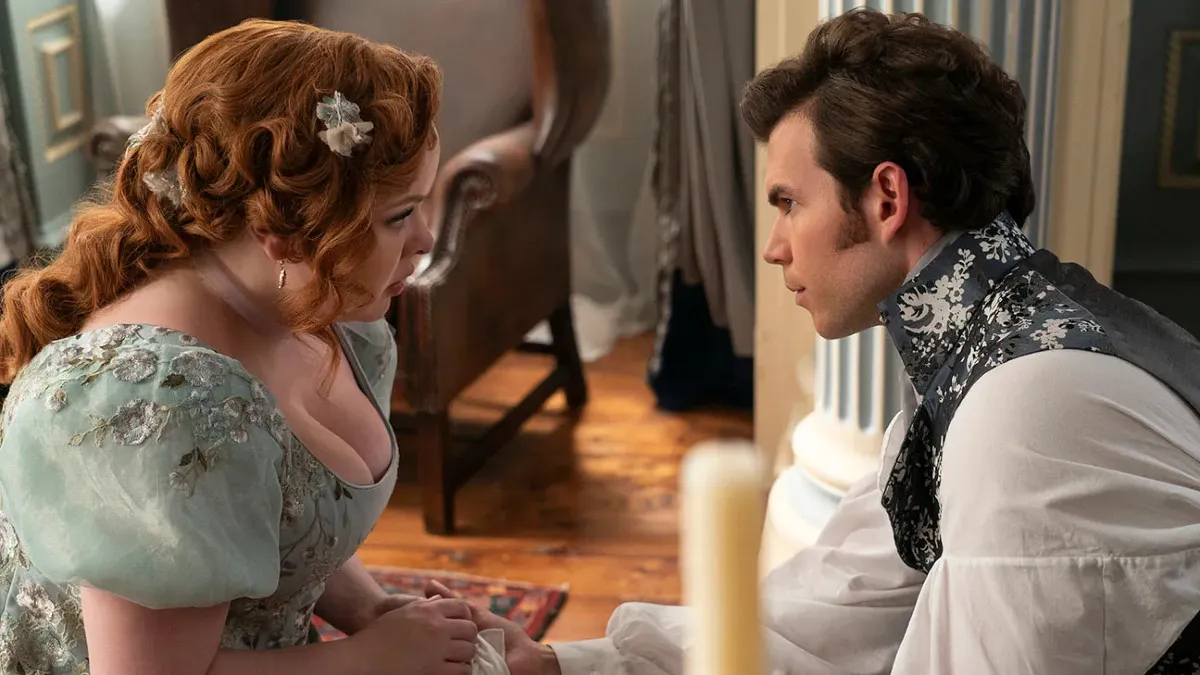
- More to Explore
- Series & Movies
Published Aug 23, 2023
The Starfleet Insignia Explained
No Star Trek symbol captures the eye or imagination quite like the delta.

StarTrek.com
"The Starfleet Symbol." "The Arrowhead." "The Delta."
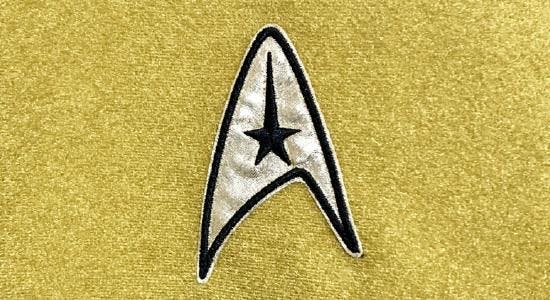
Star Trek uses symbols to convey a lot of things, but none captures the eye or imagination quite like the delta. In the years since The Original Series first aired, fans have tried to determine the meaning behind the various insignia shapes we see in the show. To most, it seems that the iconic delta shape is some sort of ship assignment patch meant to represent the U.S.S. Enterprise .
Some arrive at this conclusion because they see various Starfleet personnel wearing a number of different insignia. However, like any puzzle without a key, it’s impossible to precisely interpret the meaning of these other insignia.
The hidden key to the puzzle was finally uncovered a few years ago. The discovery was a memorandum written by producer Robert H. (Bob) Justman to costume designer William Ware (Bill) Theiss . The subject? STARSHIP EMBLEMS.
A copy of that memorandum has been digitized from the Gene Roddenberry Star Trek Television Series Collection (held in the Library Special Collections division of the Young Research Library at UCLA in Irvine, California) and is shown below:
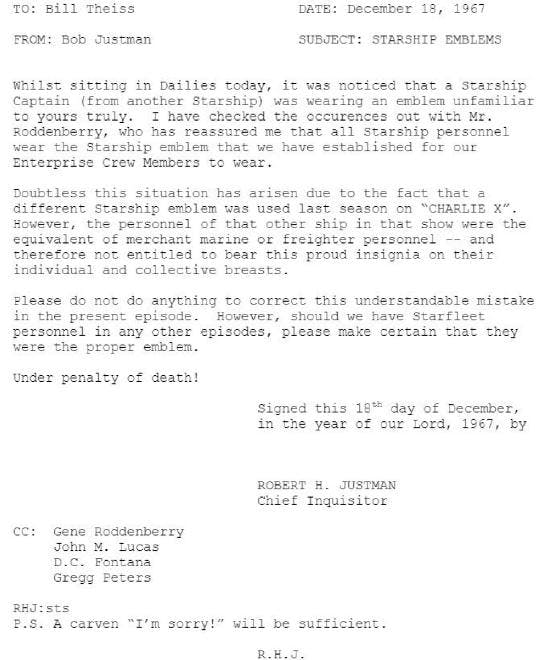
This memo, written during the production of the episode "The Omega Glory," and referencing Captain Ron Tracey, nullifies the long-held assumption that Starfleet assigned different insignia shapes to starships during TOS. Theiss’ inclusion of an alternate insignia for the Exeter 's captain and chief medical officer, unfortunately, downplays how genuinely ubiquitous the delta insignia is within the Star Trek universe. As a result, fans of the series are left with conflicting visual information regarding the meaning of the insignia worn throughout the original series.
Nearly 50 years after Bob Justman wrote his memo, we now have the opportunity to clarify the use of each and every Starfleet uniform insignia used in TOS. With a wee bit of Scotty's ingenuity, and a pinch of Vulcan logic, the complete picture of what Gene Roddenberry envisioned for the delta insignia should snap into focus.
There are six Starfleet duty insignia used in The Original Series:
- Starship Duty Insignia (Fleet personnel emblem)
- Spacecraft Duty Insignia (Auxiliary Fleet/ Merchant Marine personnel emblem)
- Outpost Duty Insignia (Outpost and Colony personnel emblem)
- Cadet Duty Insignia (Starfleet Academy student emblem)
- Starbase Duty Insignia (Headquarters, Space stations, Drydocks, and Ground installation personnel emblem)
- Fleet Command Insignia (Senior field commander personnel emblem)
In the Star Trek universe, the delta emblem is a direct descendant of the vector component of the old NASA (and later UESPA) logos in use during Earth’s space programs of the 20th and 21st Centuries. Those symbols were worn by some of the first space explorers and adorned uniforms and ships during humanity’s first steps into the final frontier.
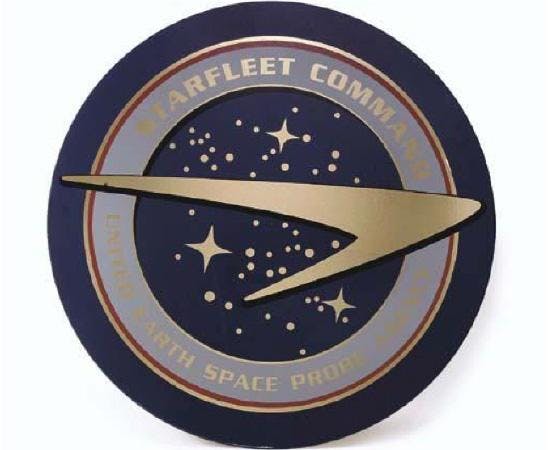
United Earth Space Probe Agency integrated with Starfleet as the leading United Earth space exploration service.
The delta insignia was first drawn in 1964 by costume designer William Ware Theiss with input from series creator Gene Roddenberry. The delta — or “Arrowhead” as Bill Theiss called it — has evolved into a revered symbol and one that's synonymous with Star Trek today.
The delta also conveys information about the wearer’s duties aboard ship using a series of division symbols. When paired with a distinctive, elongated “star,” the insignia represents someone assigned to the Command division aboard ship. When it displays the “planet” symbol, it represents the Sciences division, a stylized “e” stands for Engineering (later Operations), and a red “Swiss Cross” is worn by starship personnel assigned to the Nursing Corps.
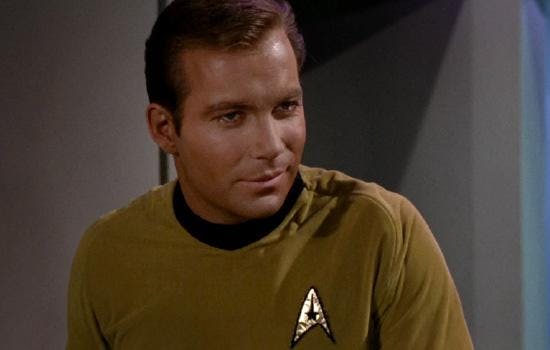
Captain James T. Kirk wearing the Starship Duty Insignia, Command Division.
Let’s continue our study of Star Trek ’s insignia with personnel assigned to other starships that are wearing the delta insignia.
Before we knew about this memo, we assumed that each ship had its own unique insignia, but there are problems that theory doesn't account for. For instance, does it bother you, or at least seem odd to see the surly guys in Starbase 11’s Officer's Club (in the episode "Court Martial") giving “their captain” a hard time over the presumed death of their mutual friend Ben Finney? Or, to see deceased crew members aboard the U.S.S. Defiant (in the episode "The Tholian Web") wearing the delta insignia?
If different starships had different symbols, why weren't they wearing them? Simple. The memo makes it clear that those Starfleet officers are not assigned to the Enterprise ; they are simply wearing Starfleet’s standard-issue Starship Duty Insignia.

Non-Enterprise Starfleet personnel in Starbase 11’s Officer’s Club in Court Martial, and Below: Deceased U.S.S. Defiant crew member wearing the Starship Duty Insignia in "The Tholian Web."
By now, you might be saying, “What about U.S.S. Exeter ’s Captain Ron Tracey and his chief surgeon, Dr. Carter?” As these two insignia patches are the error being addressed in the memo, they need no further explanation. They alone are the anomaly (an anomaly Theiss never repeated), which led to the misconception that every ship has its own assignment insignia.

Above: Captain Ron Tracey of the U.S.S. Exeter, and Below: his CMO, Dr. Carter.
As you can see here, Theiss thoughtfully, if erroneously, provided both officers with unique assignment insignia patches, and in keeping with his fastidious reputation, insured both patches included their appropriate division symbols.
Early in TOS, we get our first look at non-delta insignia. In the episode "Charlie X," Antares ’ Captain Rampart and his first officer are wearing the Spacecraft Duty Insignia, which indicates that they are assigned to an auxiliary spacecraft serving in Starfleet's Merchant Marine Corps — just as Justman points out in his memo.
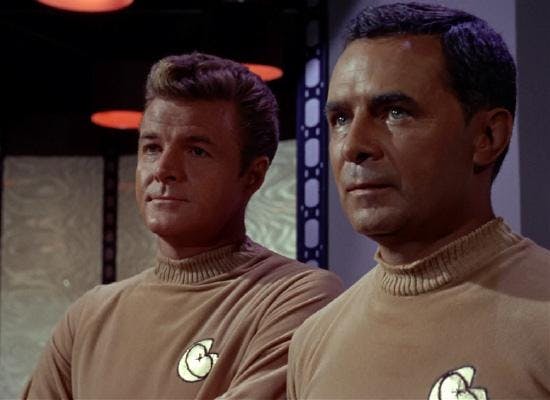
Antares' Captain Rampart, and his XO wearing the Merchant Marine Spacecraft Duty Insignia.
Not long after that, we get a look at another new insignia. The Outpost Duty Insignia is worn by Starfleet personnel assigned to outposts on the very edge of Federation space, the frontier. This emblem is characterized by a gold spikelet against a black background. Warning: Do not put yourself in a situation where this insignia goes on your uniform. Personnel wearing this badge never seem to live happily ever after.

Outpost Crew from "Balance of Terror" & "Arena" pictured wearing the Outpost Duty Insignia.
A few episodes later, the Enterprise takes shore leave and Kirk reminisces about his days at the Academy. Worn by students attending Starfleet Academy, the Cadet Duty Insignia is characterized by a pewter colored, smaller version of the Starbase Duty Insignia.
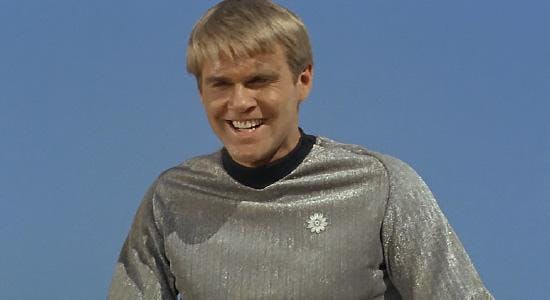
Second Class Midshipman Finnegan wearing the Cadet Duty Insignia.
First seen in "The Menagerie," the Starbase Duty Insignia is worn by personnel assigned to Federation Starbases, which include Starfleet Headquarters, space stations, drydocks, and other ground installations. The emblem, which is devoid of any departmental symbol, is a stylized representation of an “Evening Starflower” (a flowering plant native to the western hemisphere of Earth).
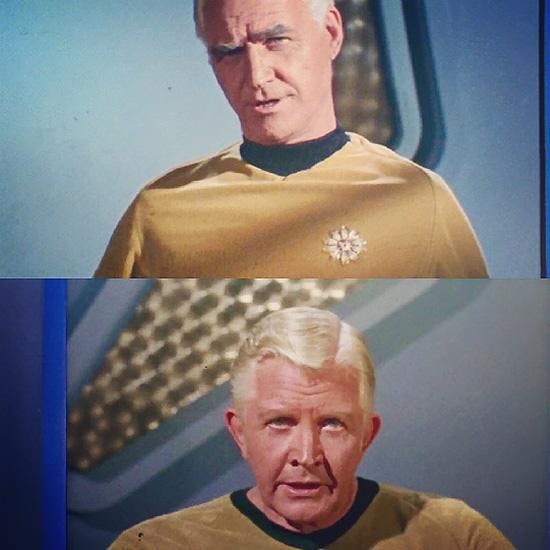
Above: Admiral James Komack of Starfleet Command - Sector 9, and Below: Admiral Fitzpatrick.
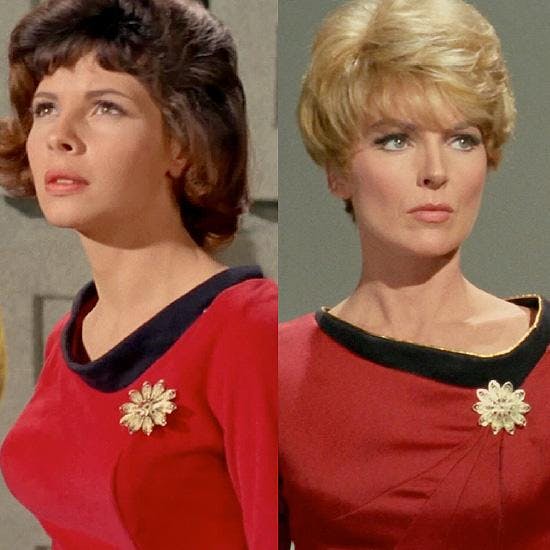
Miss Piper, assistant to Commodore Mendez, and Lt. Areel Shaw Starbase 11 JAG Officer wearing the Starbase Duty Insignia.
So how does Commodore Wesley in "The Ultimate Computer," or Commodore Decker in "The Doomsday Machine," fit into the spectrum of Starfleet insignia?
Well, let’s talk about commodores for a moment. A commodore is a flag officer rank, one position above captain. A starship captain usually commands a single vessel, but a commodore ordinarily commands more than one ship. Usually, commodores command a group of ships (either close to their flagship or distant), or in the case of TOS, they normally command a starbase.
In charge of evaluating the operational performance of the M5 computer while it's in total control of a starship, Commodore Wesley sits in temporary command of the U.S.S. Lexington to lead a battle fleet in war games against the Enterprise . Throughout the episode, Commodore Wesley continues to wear his Starbase Duty Insignia, while the Lexington crew would have been wearing the delta.
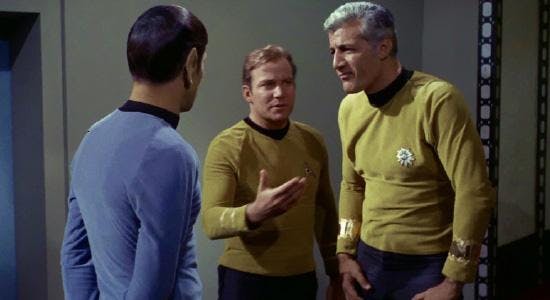
Commodore Bob Wesley in the transporter room briefing Captain Kirk and Mr. Spock about the M5 computer.
Finally, we come to one of my favorite characters ever — Commodore Matt Decker in "The Doomsday Machine." We saved him for last because we could only properly discuss his insignia and what it means after we talked about Starfleet’s other symbols first.
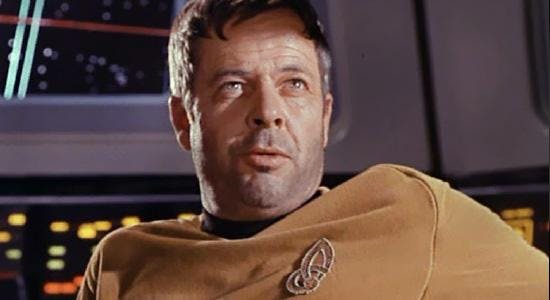
William Windom as Commodore Matt Decker
Unlike Commodore Bob Wesley, who was only in temporary command of the Lexington , Matt Decker is a Flag Officer with permanent field command of a starship. In fact, he's the only Flag Officer we see in Star Trek with a field command. As a consequence of Commodore Decker's rank and status as Commander of the U.S.S. Constellation (his flagship), he wears the Fleet Command Insignia denoting his status as a Flag Officer in the field. If we had seen Commodore Decker's crew (may they rest in peace), we would have seen the delta shape insignia in use on their uniforms. Commodore Decker's own first officer would have held the rank of Captain and worn the Starship Duty Insignia.
It should be noted that "The Doomsday Machine," which was filmed early in Season 2, is not referenced in Bob Justman’s memo. Some speculate that Decker’s absence from the memo is further indication of the inconsistent use of emblems in Star Trek , but that presupposes that the production staff missed that detail. However, the very existence of the Justman memo, and a whole forest of others just like it, demonstrates that the opposite is true.
The production team of Star Trek worked diligently to ensure that every aspect of the future they were busy creating held up under scrutiny. Gene Roddenberry was notoriously rewriting scripts himself to ensure no less than exactly what he wanted ended up on-screen, and that fastidious nature permeated the entire production staff. That Decker’s unique emblem is not mentioned in the production memo indicates that his particular insignia isn't an error at all; but represents something else.
Check out Commodore Decker's insignia. Remember that when Theiss created the insignia for Captain Ron Tracey, he went out of his way to ensure it was emblazoned with a Command Star department symbol. Commodore Decker has no such departmental symbol in his insignia patch, which places it in the same design lineage as the Starbase Duty Insignia, which is also devoid of any departmental symbol.
At this point in Star Trek , we’ve seen a number of flag officers; but they have all worn the Starflower shape, which indicates assignment to a starbase, while Matt Decker alone in TOS series serves as a flag officer in permanent command of a starship. He is wearing an insignia that conveys his unique status, the Fleet Command Insignia, and if you look closely, you'll see that Matt Decker’s emblem is visually related to the Starbase Duty Insignia. Decker’s insignia is a stylized representation of an individual petal from the same “Evening Starflower” emblem that comprises the starbase symbol. This insignia isn't mentioned in the production memo because it's not an error at all.
Hopefully, by now, you can see how consistent the Star Trek costume department really was in their use of insignia, and that Bill Thiess never repeated the error he made during "The Omega Glory" after it was pointed out by the memo.
Returning to the delta, Roddenberry and Justman intended it to be a very special symbol that communicates something important. The insignia worn on Starfleet uniforms is the equivalent of the badges worn by U.S. Service members — to show how they serve, not where they serve. Both men served with distinction in World War II. Roddenberry was an Army Air Corps pilot and Justman was a radio operator in the Navy. In the air and at sea, they understood the value of visual communication. In uniform, they themselves carried those values on their chests, on their collars, and on their sleeves. Twenty years after they wore their own various insignia, they helped to create something new — a symbol to inspire others. In the 1960s, the Starfleet delta had far more in common with the golden pin awarded to a NASA astronaut than a simple mission patch, and it was intended to equal that proud emblem in both use and sentiment.
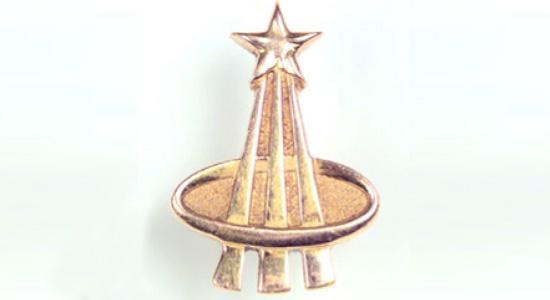
The NASA Astronaut Pin. There are two versions of this pin, a silver pin awarded to those who complete their training, and a gold pin awarded only to astronauts who have flown in space.
The delta proclaims that the person wearing it has achieved the goal of every cadet entering the Academy, and the dream of many a devoted fan — to serve aboard a starship and set sail in an endless sea of stars.
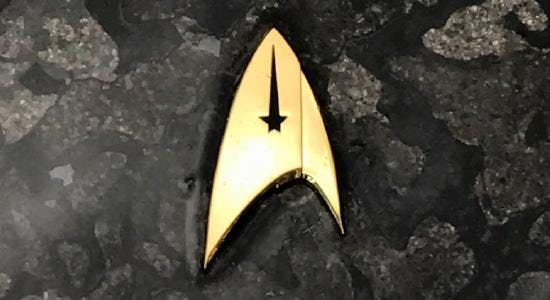
Starfleet Insignia Badge, Command Division from Star Trek Discovery
They used to say if man could fly, he'd have wings. But he did fly. He discovered he had to.
Captain James T. Kirk
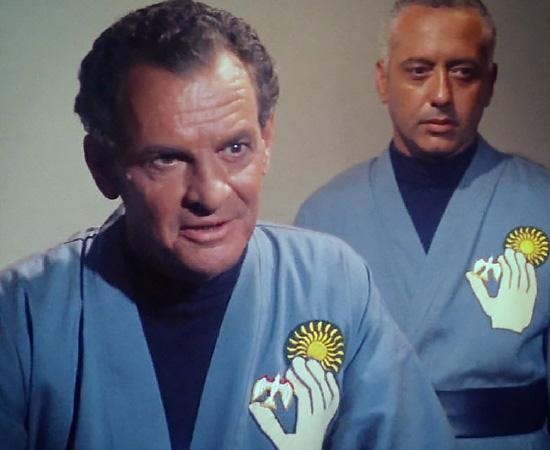
I am grateful to have an experienced and learned group of expert Star Trek fans who helped with the research on this article — Steve Fronczek, Creative Services Manager, ANOVOS; Lieutenant Commander Michael J. Quigley, United States Navy; and Dayton Ward, Star Trek author.
Get Updates By Email
This article was originally published on October 7, 2018
John Cooley is a lifelong Star Trek fan.
- Behind The Scenes
- Star Trek 101

Star Trek: Discovery’s Uniforms, Decoded
Starfleet uniforms get a dramatic redesign for Star Trek: Discovery. Here's how to tell an executive officer from a security lieutenant.
Star Trek has a long tradition of color-coded uniforms that signify in which divisions Starfleet personnel serve. Perhaps most memorably, on The Original Series command division was gold, science and medical were blue, and operations, engineering and security were red. Naturally, that approach continues on CBS's franchise revival Star Trek: Discovery , with some notable alterations.
RELATED: Every Star Trek TV Pilot, Ranked
Set a decade before Kirk, Spock & Co. set off on their five-year mission, the new show eschews the bright colors of The Original Series , and opts instead for uniforms more akin to those of Enterprise , the 2001-2005 drama that took place about a century earlier, during the early days of interstellar travel. The color piping on the blue fitted jumpsuits corresponded with each of the divisions of the beloved 1960s television series, but designated ranks with silver pips displayed on the right chest, rather than on the sleeves.
"We looked at Enterprise ," executive producer Akiva Goldsman recently explained , "we looked at The Original Series , at that point in canon, and we tried to pull across the color palette."
However, Discovery trades in the Skittles rainbow for something a little more subdued (albeit a lot more metallic), with gold, silver and bronze, a little closer to the divisional designations used in the unaired 1965 pilot "The Cage."
"We are looking at doing the red, blue and gold shirts," said costume designer Gersha Phillips. "We've come up with a system where we're doing a foiled compression panel and delta panels that we're putting in on the jackets that tell that same story of the departments."
As with The Original Series and its prequel Enterprise , the Starfleet uniforms of Discovery use gold to designate the command division, which traditionally encompasses officers and crewmen in command (of course) and control functions. That includes captains, executive officers, helmsmen and navigators.
RELATED: Star Trek: Discovery Will Push Boundaries, Drop F-Bombs, When Necessary
On Star Trek: Discovery , First Officer Michael Burnham (Sonequa Martin-Green), Captain Gabriel Lorca (Jason Isaacs) and Captain Philippa Georgiou (Michelle Yeoh) notably wear gold accents.
Instead of the blue of The Original Series , silver is used on Discovery to specify the sciences division, which covers Starfleet officers and crewmen in scientific and medical research and control functions. Those can include a wide range of departments and duties, from sensors and research to surgery and medics.
On Discovery , science officers Saru (Doug Jones) and Paul Stamets (Anthony Rapp), and medical officer Hugh Culber (Wilson Cruz) notably wear silver accents.
The largest division of most any Starfleet crew, operations encompasses such functions as engineering, security, communications and tactical. On The Original Series operations personnel wore red, which gave rise to the term "redshirt," meaning a stock character who dies soon after being introduced. However, on Discovery , operations officers and crew are designated by bronze accents on their blue uniforms.
RELATED: Star Trek: TNG's "Sarek" Is Required Viewing Before Discovery
On the new series, operations personnel include security officer Lt. Ash Tyler (Shazad Latif) and Cadet Sylvia Tilly (Mary Wiseman).
Ranks and Division Badges
The color coding of the Starfleet uniforms on Star Trek: Discovery continues with the metallic badges, which correspond to the gold, silver and bronze of each of the divisions. What's more, those badges display the division insignia as seen on The Original Series : the stylized star for command, a "ringed planet" for sciences and a spiral for operations.
But there's a twist, with ranks on Discovery indicated with pips, akin to those of Star Trek: The Next Generation , only here displayed on the badges themselves: four pips for a captain, three for a commander, and so on.
In the United States, Star Trek: Discovery debuts Sunday, Sept. 24, at 8:30 p.m. ET/PT on CBS, before moving to the CBS All Access streaming service for subsequent episodes. In Canada, the series debuts on CTV and Space at 8:30 pm ET, with its second episode set to air immediately after on Space — subsequent episodes will air Sundays through Nov. 5. Internationally, the series will stream on Netflix.
Star Trek Has Finally Revealed the Evil Enterprise's Weird Fate
Watch out for any goatees.

Today, everyone knows what a multiverse is. But back in 1967, parallel universe stories weren’t nearly as common as they are now, even within the sci-fi genre. A classic Star Trek episode, Jerome Bixby’s “Mirror, Mirror,” helped popularize the alternate universe trope, complete with meaner versions of yourself who may rock an evil little goatee like Mirror Spock.
Star Trek’s Mirror Universe also gave us an alternate version of the USS Enterprise in the ISS Enterprise , a ship that served the Imperial Terran Empire, not the United Federation of Planets. Now, in the Discovery Season 5 episode “Mirrors,” the evil ISS Enterprise is back... as a force for good. Here’s what it all means. Spoilers ahead.
The ISS Enterprise returns
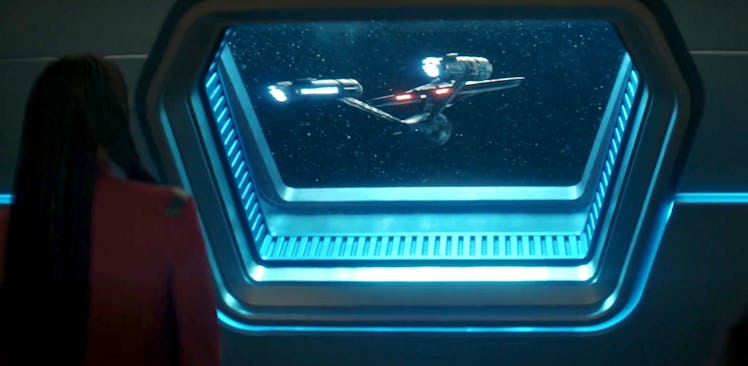
Captain Burnham watches the ISS Enterprise warp to Federation HQ.
While pursuing the thieves Moll and L’ak, Book and Burnham take a shuttlecraft into an unstable wormhole and discover the floating, pseudo-derelict ISS Enterprise . One of the clues to the Progenitor’s tech has been hidden on it, but for Burnham, it’s kind of like a bizzaro universe homecoming. Burnham spent a decent amount of time in the Mirror Universe in Discovery Season 1 , and in Season 2 she found herself on the Enterprise with her brother Spock just before jumping from the 23rd century to the 32nd century.
In “Mirrors,” Burnham notes that “crossing between universes has been impossible for centuries,” which means the ISS Enterprise must have crossed over into the Prime Universe well before the 32nd century. Burnham is referencing the events of Discovery Season 3, when we learned that Philippa Georgiou, a resident of the Mirror Universe, couldn’t go back to her home universe because those dimensions had drifted apart. But the ISS Enterprise , which was previously captained by an evil Kirk, crossed over into the Prime Universe well before that moment, and Discovery has now added details connecting The Original Series, Deep Space Nine , and Discovery Season 3.
How evil Spock became good
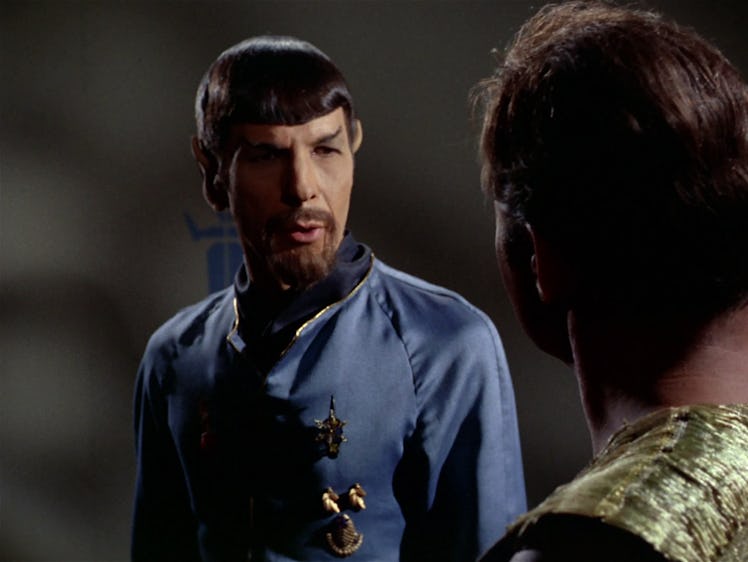
Spock talking with Kirk in “Mirror, Mirror.”
In the Deep Space Nine episode “Crossover” we learn that after Kirk talked to Mirror Spock and encouraged him to try making the Terran Empire a peaceful power, Mirror Spock did just that. But as Mirror Kira explained, Mirror Spock’s idealism didn’t work out the way he’d hoped:
“Spock rose to Commander in Chief of the Empire by preaching reforms, disarmament, peace. It was quite a remarkable turnabout for his people. Unfortunately for them, when Spock had completed all these reforms, his empire was no longer in any position to defend itself against us [the Klingon-Cardassian Alliance].”
Discovery appears to be referencing this exact event, even if Spock isn’t named outright. When Book learns the ISS Enterprise became a refugee ship for people who’d turned against the Empire, he says, “The Terran High Chancellor was killed for trying to make reforms.”
This likely references Spock, but adds the twist that he was perhaps betrayed by other people within the Terran Empire, even if Earth adopted his reforms. Now, by the end of “Mirrors,” the 23rd-century ISS Enterprise has been moved to the Prime Universe and the 32nd century. It’s an antique by modern standards, but it’s a contemporary of the USS Discovery, so it’s still serviceable. This means that by the end of Discovery Season 5 there will still be a version of the classic Enterprise floating around Federation headquarters, so when the Starfleet Academy series debuts, 32nd-century Starfleet cadets will have access to the classic version of the most famous Enterprise. It may technically be an evil twin, but its historic adventures aren’t over just yet.
Star Trek: Discovery and The Original Series stream on Paramount+.

- Science Fiction

Star Trek's Section 31 Are Becoming a Literal God-Level Villain - Theory Explained
- In Star Trek #19, the sinister Section 31 enters the franchise-spanning god war.
- Section 31's agenda with Ensign Sato and the crew of the Theseus remains a mystery for now.
- Section 31 having access to the Pleroma could spell bad news for the galaxy.
Warning: contains spoilers for Star Trek #19!
The secretive Section 31 are set to become god-level villains in the Star Trek universe. Working from the shadows, Section 31 works to keep the Federation safe–no matter the cost. Controversial among Star Trek fans, Section 31 has nonetheless become a fascinating part of the lore. Now, in Star Trek #19, the agency approaches one of Sisko’s crew with an offer that may doom the universe.
Star Trek #19 is written by Jackson Lanzing and Collin Kelly and drawn by Megan Levens. Throughout Star Trek’s previous storyline, Ensign Sato became more and more disillusioned with Starfleet and the Federation. At the end of issue 19, she is approached in her quarters by a man identifying himself as “Martin” and using a person named Sloan’s override. Martin appeals to Sato’s growing dissatisfaction, telling her that “mistakes have been made” and certain Starfleet officials “lack leadership.”
Martin then offers Ensign Sato a job with Section 31.
Section 31 Is The Darkest Aspect of Star Trek Lore
Section 31 has a long history of violence and terror.
Star Trek depicts a utopian society that has moved beyond money and the need to acquire wealth. This idea is embodied in the United Federation of Planets. An organization such as Section 31, that works in the shadows and routinely uses torture and murder to further their ends, would seem at odds with Gene Roddenbery’s optimistic view of humanity. Indeed, Section 31 has proven to be a point of contention among fans. Some portions of Star Trek fandom oppose it because it violates the show’s core principals, while others have hailed it as giving the franchise nuance.
Star Trek's Original Ban on Female Starship Captains Is Even Weirder Than It Seems
Section 31 first appeared in Star Trek: Deep Space Nine’s sixth season, in the episode “Inquisition.” Created by Deep Space Nine’s creative team to explore the darker sides of Federation life, Section 31 works to keep the Federation a paradise. However, their means are extreme. Section 31 has been responsible for assassinations and staging coups. They have allegedly infiltrated nearly every other agency in the Federation, giving them eyes and ears everywhere. The closest real-world analogy to Section 31 is the Central Intelligence Agency. Section 31 also finds echoes in the Romulan Tal’Shiar and the Cardassian Obsidian Order.
A handful of Star Trek episodes, including the Original Series episode "The Enterprise Incident" and The Next Generation's "The Pegasus" have been retconned to have involved Section 31.
No Star Trek show or movie has explored the history of Section 31, but it is (chronologically) one of the oldest agencies in the franchise. They derive their authority from Article 14, Section 31 of Starfleet’s charter, hence the name. This part of the Starfleet Charter allows the organization to take extreme measures in times of great crisis. Section 31 has been active at least as early as the 22nd century. Malcolm Reed, the Tactical Officer under Captain Jonathan Archer, was affiliated with Section 31 earlier in his career.
By the 23rd century, Section 31 had grown, and seemed to be working even further undercover. The agency had a presence on board the USS Discovery, which was using the then-new “spore drive,” that tapped into a universal mycelial network. Discovery’s affiliation with the agency only grew as crew member Ash Tyler was recruited, as was Empress Phillipa Georgiou, from the Mirror Universe. Finally, the AI Section 31 relied on, tried to seize control of the agents, and use them to unleash chaos on the galaxy. Discovery was instrumental in stopping Section 31, but was sent to the future.
Star Trek: Earths First Deep Space Colonists Evolved Into a New Species
In the 24th century, Section 31 was instrumental during the Dominion War. As the war dragged on, and casualties began to pile up, Section 31 bioengineered a virus that could kill Changelings. During this time, the agency approaches Doctor Julian Bashir, seeking to recruit him. Much like Ensign Sato in Star Trek #19, Section 31, represented by Luther Sloan, approaches Doctor Bashir in his quarters. However, unlike Sato, Section 31 did not find a receptive audience in Doctor Bashir. Bashir also finds a cure for the virus Section 31 designed, which helped end the Dominion War.
Although Section 31’s plans to use their virus were thwarted, the agency still took an interest in Changelings. Season three of Star Trek: Picard revealed that Section 31 experimented on Changelings, even after the war’s conclusion. These rogue Changelings broke free of Section 31, and in an act of blowback, killed thousands of Federation citizens. They also allied themselves with the Borg Queen, who also sought revenge against the Federation. Section 31 is even still active in the 32nd century, as seen in subsequent seasons of Star Trek: Discovery.
Section 31 has also appeared in the Kelvin Universe films, including 2013's Star Trek: Into Darkness
Despite the moral ambiguity of Section 31, it has proven irresistible to generations of Star Trek writers and directors. The agency has been a part of nearly every Star Trek show since its introduction on Deep Space Nine , even Lower Decks . The gray areas Section 31 works in provide even more depth and substance to the Star Trek universe. Deep Space Nine regularly explored the darker sides of Starfleet and life in the Federation, and Section 31 was perhaps its most scathing interrogation of these ideals. Section 31 showed that even a utopia can have a dark side.
Section 31 Adds Darkness--And Depth, to the Star Trek Franchise
Section 31 can change the course of the god war.
And now Section 31 is seemingly joining the franchise’s god war–but in what capacity remains to be seen. Previous issues of Star Trek have seeded Section 31. Harry Kim had seemingly allied himself with them. Kim worked closely with Ensign Sato during the Tzenkethi crisis, which may have led to her recruitment. In a recent interview with ScreenRant , Star Trek writers Jackson Lanzing and Collin Kelly commented on Section 31’s involvement, cryptically teasing that the answer may lie in the distant past, as opposed to more recent events. They did not elaborate on this further.
Jackson Lanzing & Collin Kelly are no strangers to the Star Trek comics universe, having masterminded Year Five , also from IDW.
In the same interview, Lanzing and Kelly discussed Sloan’s presence, or lack thereof. Martin, the agent sent to bring Ensign Sato into the fold, invokes Sloan’s name in his override code. Lanzing and Kelly pointed out Martin is not Sloan in disguise. However, Martin’s use of Sloan’s code is another hint, they revealed. Elaborating on the point, Lanzing stated that some Section 31 agents may feel Sloan did not go far enough in his plans. This would echo Martin’s comment about Starfleet officials “lacking leadership.” The murderous and duplicitous Sloan has become a rallying point for Section 31.
Kahless’ recent crusade against the gods of the Star Trek universe no doubt caught Section 31’s attention. The god war Kahless instigated threatens far more than the Federation, but the entire fabric of reality as well. The god war is the exact type of situation Section 31 was designed to combat. Section 31 has access to technology the average Starfleet officer does not, which can give them an edge in a fight with Kahless or his god-killer. Furthermore, the god war also fundamentally altered Lore. Now on a quest for godhood, Lore must be stopped as well.
Are Section 31's Intentions Truly Honorable? Or Are They Merely Looking Out for Themselves?
With kahless' god-killer technology, section 31 could be unstoppable.
Section 31 may also have less than noble intentions by recruiting Ensign Sato. Sato, and the rest of the Theseus’ crew, are headed to the Pleroma, the newly revealed “realm of the gods.” The Theseus’ excursion to the Pleroma represents a new frontier in knowledge for the Federation, but it could also be a huge threat as well, one Section 31 will want to be well primed on. Kahless and his god-killer have proven that the franchise’s god like beings can be killed, a technology Section 31 might want their hands on too.
How Marvel's Avengers Inspired Star Trek's New Comic Era
Star Trek #19 advances a horrifying notion: Section 31 having control of the Pleroma. If Section 31 gets their hands on Kahless’ technology, they can use it to extort and threaten the beings in the Pleroma. Bringing these beings under their thumb, Section 31 could become a truly existential threat to the Star Trek universe. With god-like powers at their disposal, Section 31 could implement and maintain one of the most oppressive surveillance systems ever known. Dissension will become a thing of the past, as Section 31 imposes their will on the rest of the Star Trek universe.
Star Trek #19 is on sale now from IDW Publishing!

Screen Rant
Who was airiam star trek: discovery’s tragic cyborg officer explained.
Everything you need to know about Lt. Commander Airiam, the 23rd century cyborg Starfleet officer in Star Trek: Discovery, and her tragic story.
Warning: This Article Contains SPOILERS For Star Trek: Discovery Season 5, Episode 4, "Face the Strange".
- Star Trek: Discovery season 5 episode 4 brought back Lt. Commander Airiam, who died in season 2.
- Airiam was an augmented human USS Discovery officer who was taken over by the enemy A.I. Control.
- Airiam was played by Sara Mitich in Discovery season 1 and Hannah Cheesman in season 2; Cheesman returned as Aiiam in season 5.
Star Trek: Discovery shockingly brings back Lt. Commander Airiam (Hannah Cheesman) in Star Trek: Discovery season 5, episode 4 , "Face the Strange", written by Sean Cochran and directed by Lee Rose. Captain Michael Burnham (Sonequa Martin-Green), Commander Rayner (Keith Callum Rennie), and Commander Paul Stamets (Anthony Rapp) are forced to hop through different eras of the USS Discovery's past and future. Their time travel puzzle places the trio back in Star Trek: Discovery season 1, when the USS Discovery was commanded by Captain Gabriel Lorca (Jason Isaacs). Instead of Lorca, however, Burnham finds that Airiam is in command, a year before Airiam's death in Star Trek: Discovery season 2.
The cyborg Airiam's unique appearance stands out among the mostly human characters in Star Trek: Discovery , inviting curiosity as to Airiam's origin. With striking blue eyes and facial features divided into pale white and silver chrome segments, Airiam could have been a member of an alien species new to Star Trek: Discovery , like the Kelpien Commander Saru (Doug Jones), or a 23rd-century synthetic life form, like a precursor to Star Trek: The Next Generation 's Lt. Commander Data (Brent Spiner). Neither an alien nor an early android, Lt. Commander Airiam was an augmented human, enhanced with cybernetic parts after a shuttle accident that left Airiam in critical condition and killed Airiam's new husband.
Star Trek: Discovery Season 5 Returning Cast & New Character Guide
Who was airiam & how did she die in star trek: discovery, airiam sacrificed herself to protect the future of sentient life..
Lt. Commander Airiam was a cyborg science officer who served on the USS Discovery in Star Trek: Discovery seasons 1 & 2, and often took command of Discovery when the Captain and First Officer were not available. As the spore drive operations officer, Airiam worked as a liaison between Discovery's command crew on the bridge and Lt. Commander Paul Stamets in engineering. Airiam was close with the rest of the USS Discovery's bridge crew, and counted Ensign Sylvia Tilly (Mary Wiseman), Lt. Joann Owosekun (Oyin Oladejo), and Lt. Keyla Detmer (Emily Coutts) as some of her closest friends. Burnham didn't know Airiam well then, but would soon.
Airiam's enhancements were sometimes a boon, like when processing 10,000 years of data from the Sphere, but also ultimately led to Airiam's death in Star Trek: Discovery season 2, episode 9, "Project Daedalus". Control, the threat assessment A.I. developed by Starfleet's Section 31, hijacked Airiam through her cybernetic augmentation to get to the Sphere data, with the goal of becoming sentient and wiping out sentient life. Control managed to get 25% of the Sphere data before Airiam realized her death would be the only way to stop Control. Airiam pleaded with Burnham and Lieutenant D. Nhan (Rachael Ancheril) to release Airiam from an airlock, and Nhan ultimately complied.
In Star Trek: Discovery season 3, Lt. Nhan stays on the USS Discovery in the 32nd century to honor Lt. Commander Airiam's sacrifice.
2 Actors Played Airiam In Star Trek: Discovery
Sara mitich and hannah cheesman both played lt. commander airiam..
Star Trek: Discovery 's Lt. Commander Airiam was played by two different actors, starting with Sara Mitich playing Airiam in Star Trek: Discovery season 1. Mitich may have had an allergic reaction to the cyborg makeup, which would prevent her continued performance as Airiam after Star Trek: Discovery season 1. Instead of leaving, Airiam's original actress played Lt. Nilsson , a new human character, beginning in Star Trek: Discovery season 2. After Airiam's death, Nilsson took over the role of spore drive ops officer, and stayed on the USS Discovery in the 32nd century until Star Trek: Discovery season 5, when Nilsson transferred to the USS Voyager-J.
Hannah Cheesman took over the role of Lt. Commander Airiam in Star Trek: Discovery season 2, and played Airiam again in Star Trek: Discovery season 5, episode 4, "Face the Strange". Although the episode revisited Discovery season 1, when Sara Mitich played Airiam, it made sense that Airiam's second actress, Hannah Cheesman, returned to Star Trek: Discovery . The story relies on having a consistent through line from the connection between Cheesman's Airiam and Michael Burnham before Airiam's tragic death in Star Trek: Discovery season 2, episode 9, "Project Daedalus", and Airiam and Burnham meeting in Discovery season 5, episode 4, "Face the Strange".
Hannah Cheesman also plays a fully human version of Airiam seen in flashback recordings from before Airiam's accident in Star Trek: Discovery season 2, episode 9, "Project Daedalus".
Why Airiam Was Key To Star Trek: Discovery Season 5’s Time Travel
Burnham's knowledge of airiam's death proved valuable..
Lt. Commander Airiam was the key to solving the time travel problem in Star Trek: Discovery season 5, episode 4, "Face the Strange". Stamets' plan to contain the time bug by breaking Discovery's warp bubble required cooperation from Discovery's bridge crew in order to work, an impossible task to achieve at a time when Discovery's captain was Captain Gabriel Lorca (Jason Isaacs) and Michael Burnham was considered an untrustworthy mutineer. Fortunately, the duty roster revealed Lorca was not on the USS Discovery , and Airiam was in command, so Captain Burnham's job of convincing the bridge crew to help was downgraded from impossible to merely difficult.
Although Burnham wasn't particularly close to Lt. Commander Airiam, Michael was present when Airiam died, and privy to all the pain of Airiam's last moments. Burnham's testimony of Airiam's death was met with protest from Detmer and Owosekun but unlocked a solemn understanding from Airiam herself. Airiam knew herself, and what she would do, far better than even her friends did. Convinced that Burnham was telling the truth about being from the future, Airiam allowed the plan to proceed, and helped get the USS Discovery out of its time loop. Just like in Discovery season 2, Lt. Commander Airiam's trust saved the future in Star Trek: Discovery season 5.
Star Trek: Discovery streams Thursdays on Paramount+.
Star Trek: Discovery

IMAGES
VIDEO
COMMENTS
"Star Trek" is definitely a technicolor wonderland of a show. That sense of eye-catching brilliance trickles down from the background scenery to the props used by each cast member, all the way to ...
Star Trek's iconic uniforms have through a variety of changes in color designation and design in the past 57 years for a variety of reasons.In Star Trek: The Original Series' unaired pilot, there were only two colors - blue for the science and medical divisions and gold for everybody else.Due to the costs involved in mounting a second pilot for the network, the gold uniforms were retained for ...
But it's the different colors of the Starfleet uniforms that really tell the story of how the Enterprise operates. Fans know the basics: an array of blue, red, and gold shirts line the bridge of ...
In "Star Trek II: The Wrath of Khan," a new standard was established, and the all-red, Christmas sweater-like uniforms would remain the standard through at least the 2350s. "Star Trek: The Next ...
Commanding Officers of Star Trek Image: Paramount. The classic shirt color of those in command positions is gold. Unless we're talking about Captain Kirk's green formal top in the "Journey to Babel" episode of The Original Series. (Captains Pike and Kirk revive these prime colors in Strange New Worlds.)Then Captain Picard came along in The Next Generation and the colors shifted to red ...
In Star Trek: The Original Series, which ran from 1966 to 1969, you can't miss the brightly hued uniform shirts sported by the crew of the starship Enterprise.Captain James T. Kirk and other members of the command staff sport golden yellow tops, says Mental Floss.Blue is reserved for the science department and medical personnel, so you'll see it on Mr. Spock, the second-in-command, and the ...
The original crew in their tri-color uniforms. In the original Star Trek series, which ran from 1966-1969 (or roughly from 2254 to 2269, in universe), there were three standard uniform colors ...
Star Trek uniform colors explained. The basic colors that outline Star Trek as a whole are an array of blue, red and gold. These colors line the bridge of the ship in every episode, and relate specifically to the various occupational roles that are performed on the ship. Each member wears the color that corresponds with that specific class or ...
Featured briefly in the opening scene of J.J. Abrams first Star Trek film - with Thor's Chris Hemsworth as George Kirk - these uniforms were something of a middle ground between the look of Enterprise and Star Trek: The Original Series.The jumpsuits were now replaced by tight fitting spandex, but still in fairly muted colors, with blue for command, gold for operations, and grey for sciences.
The two Star Trek pilots-- "The Cage" and "Where No Man Has Gone Before" -- established the basics of Star Trek's uniform colors.But the tones were muted and understated, and the rapid expansion of color TV in the 1960s demanded something that popped. The Original Series brightened the colors while formally distinguishing what each one meant: red for security and engineering departments ...
Blue shades indicate ship medics and scientific personnel. Gold Uniforms: Worn by command officers, gold symbolizes the importance of strategic decisions. Command staff, including Captain Kirk, would wear these iconic golden shirts. TNG, DS9 & Voyager. In Star Trek: The Next Generation (TNG), and beyond, not only did the uniforms modernize, the ...
Star Trek uniforms are costumes worn by actors portraying personnel of a fictitious Starfleet in various television series and films in the Star Trek science fiction franchise. During the various series, the costume design has often changed to represent different time periods and for reasons of appearance and comfort. Sometimes different styles were deliberately mixed to enhance the sense of ...
Because the costume colors signify a crewman's role on their particular ship, and the color scheme changed between TOS and TNG. Although some Trekkies hate to admit it, Star Trek didn't really ...
Star Trek's Different Uniform Colors And Their Meanings Explained. The Starfleet uniforms seen on the original "Star Trek" series back in 1966 were designed by William Ware Theiss, a costume ...
The Original Series three uniform colors. The Original Series. blown up plunge head-first surgically removed 26 officers The Apple. Strange New Worlds The Original Series The Original Series. Star ...
For most of Star Trek's history, Starfleet uniforms have had at least three division colors.Some characters have worn different division colors in different episodes. Leslie, Jae, Tom Paris, Harry Kim, and Sylvia Tilly have each been shown wearing three colors at different points (including, for Paris and Kim, alternate timelines and holodeck scenarios); however, the first character to wear ...
Here's a quick breakdown on the Star Trek uniform colors from the Original Series: The command division wore gold shirts. This includes Captain Kirk, Lieutenant Sulu, and Pavel Chekov. The science and medical staff wore blue shirts. This includes Lieutenant Commander McCoy and Commander Spock. The engineering and communications division wore ...
2350s. Image: CBS. Fast-forwarding an entire generation, the Starfleet of TNG's era decided to go back to big, bold colors—and a lot of black accents. The classic colors returned, but which ...
The Original Series. For the original Star Trek series and the Enterprise prequel that came later, the uniform color breakdowns are:. Red - Engineering, Security, and Communications. Blue ...
You may have noticed that the colour of the captains uniform went from gold to Red and black... why would this happen? Todays video attempts to explain that ...
The Starfleet Insignia Explained. No Star Trek symbol captures the eye or imagination quite like the delta. "The Starfleet Symbol." "The Arrowhead." "The Delta." Star Trek uses symbols to convey a lot of things, but none captures the eye or imagination quite like the delta. In the years since The Original Series first aired, fans have tried to ...
The uniforms typically seen in Star Trek: Voyager are the Standard Duty Uniform style that was introduced in 2369 - nearly two years before Voyager found itself stranded in the Delta Quadrant.. As with other TNG-era uniforms, there are three division colors used on the uniforms: Red/Maroon - this denotes the COMMAND division. Examples are anyone on the command track, including helmsmen ...
Star Trek has a long tradition of color-coded uniforms that signify in which divisions Starfleet personnel serve. Perhaps most memorably, on The Original Series command division was gold, science and medical were blue, and operations, engineering and security were red. Naturally, that approach continues on CBS's franchise revival Star Trek: Discovery, with some notable alterations.
Star Trek: Discovery reveals that the Terran High Chancellor was killed for trying to make reforms, which is presumably a reference to Mirror Spock.In Star Trek: Deep Space Nine season 2, episode 23, "Crossover", it was confirmed that Mirror Spock rose to the role of Commander in Chief, and the peaceful reforms led to the Terran Empire being unprepared for war with the Klingon-Cardassian Alliance.
Today, everyone knows what a multiverse is. But back in 1967, parallel universe stories weren't nearly as common as they are now, even within the sci-fi genre. A classic Star Trek episode ...
Star Trek: Voyager's Executive Producer Brannon Braga explained his real inspiration behind the episode where Captain Janeway (Kate Mulgrew) becomes Ellen Ripley (Sigourney Weaver) from Alien ...
Episode 4 of Star Trek: Discovery aired on Paramount Plus this week,as it approaches the halfway mark in the fifth and final season. The sci-fi spin-off series consists of ten episodes, with one ...
Star Trek: Discovery season 5, episode 5, "Mirrors", shockingly brought the ISS Enterprise into the 32nd century, and the starship's dedication plaque reveals new details about the Mirror Universe's history. Written by Johanna Lee and Carlos Cisco and directed by Jen McGowan, "Mirrors" brought Captain Michael Burnham (Sonequa Martin-Green) and Cleveland Booker (David Ajala) into ...
In Star Trek #19, the sinister Section 31 enters the franchise-spanning god war.; Section 31's agenda with Ensign Sato and the crew of the Theseus remains a mystery for now.; Section 31 having ...
Star Trek: Discovery's Lt. Commander Airiam was played by two different actors, starting with Sara Mitich playing Airiam in Star Trek: Discovery season 1. Mitich may have had an allergic reaction to the cyborg makeup, which would prevent her continued performance as Airiam after Star Trek: Discovery season 1. Instead of leaving, Airiam's original actress played Lt. Nilsson, a new human ...